Fantasy Books
Review: A Letter to the Luminous Deep by Sylvie Cathrall

Buy A Letter to the Luminous Deep
OFFICIAL AUTHOR BIO: Sylvie Cathrall writes stories of hope and healing with healthy doses of wonder and whimsy. She holds a graduate degree in odd Victorian art and has handled more than a few nineteenth-century letters (with great care). Sylvie married her former pen pal and lives in the mountains, where she dresses impractically and dreams of the sea.
FORMAT/INFO: A Letter to the Luminous Deep was published by Orbit Books on April 25th, 2024. It is available in paperback, ebook, and audiobook formats.
OVERVIEW/ANALYSIS: One year ago, a disaster struck the underwater residence known as the Deep House, leaving its two inhabitants, E. and Henerey, presumed dead. After a year of grieving, E.'s sister Sophy and Henerey's brother Vyerin begin to investigate the events that led to their siblings' death. Sifting through correspondence between the many individuals involved, the two begin to uncover a much more ominous mystery than they expected.
A Letter to the Luminous Deep is a charming underwater tale that ultimately dragged too much to keep me hooked. This is a very slow-paced affair, told largely through letters written in the style of the late 1800s. This is certainly a difficult form of novel to pull off. For one, there are occasional moments where the author has to do some narrative contortions to explain why certain events or conversations were put to paper. While I understand the necessity in order to convey certain key information to the reader, it does strain the credulity a bit in some places.
That said, there were also numerous ways the narrative structure worked. I did enjoy the subtle ominous foreboding that builds up over the course of the story. Certain innocuous observations of things that are "off" in the world begin to create an unsettling pattern, especially as we have a rough idea of how events end. Several people each have a piece of the puzzle, but it's only in assembling those pieces by collecting these letters that they (and the audience) start to see the whole picture.
I also liked the slow romance between the two characters of E. and Henerey. Each is a shy or reticent person for various reasons. Through the letters, however, we can see two people being understood in a way they haven't before. The use of aborted "first drafts" of letters also lets us see a little glimpse of their respective nervousness as they try to fumble through how to address a person they've developed feelings for, even though they've never met in person.
The author has also built up a fascinating maritime culture. Some calamity 1000 years ago left this fantasy world with minimal inhabitable land. As a result, whole peoples live one boats or floating collectives. As our focus in this story is on the colleges and scholarly life of these people, most of the details do remain frustratingly out of sight, but perhaps not unreasonably. The people writing the letters are focused on their own narrow slice of life, not on the workings of society as a whole.
CONCLUSION: While I did enjoy my read of A Letter to the Luminous Deep overall, I found it struggled to hold my attention towards the end. The narrative structure of letters just dragged events out. We have a good idea of what happened some thirty pages or so before the ending, with the rest of the characters trying to catch up through their long-winded missives. As someone who struggles with slow books, ultimately this just didn't click for me. While the set up for part two of the duology is intriguing, this tale simply isn't my cup of tea.
How to Survive “Interesting” Times
 Image by Ervin Gjata from Pixabay
Image by Ervin Gjata from Pixabay
Good afterevenmorn (or whenever you’re reading this)!
Welp, what a start to 2025. Personally, it hasn’t been great. I kicked off the year very ill (thanks, Covid), languishing in bed wondering if this was the moment I drown without ever touching water. ‘Twas not pretty. Looking wider, the world appears to be literally on fire, or underwater, or deliberately reduced to rubble. It’s not been a good time for a whole lot of folks. I have been taking care of myself by largely staying off social media (sorry if I was missed. But I was already overwhelmed and unable to cope with my own busy-ness, let alone the worries of the world at large), and engaging in art. Not creating physically, as I’ve been very unwell, but consuming, art. Okay, I’ve been watching lots of Chinese dramas (some of which I don’t remember because I was in a feverish haze). That still counts, though.
I’ve also been daydreaming a lot, which is usually the important first step in my creative process. I have a new book in my head. All I need to do is finish the book I’m working on now, and then sit down and draw out this story word by word. I expect that it will become my next free online serial.
Though I’m sick… again (not Covid this time, just an annoying flu)… I’m in a much better place, coping-wise. And I owe that to art.
 Some art, to cheer up the page.
Some art, to cheer up the page.
It has been a recent (or not so recent, depending on your perspective) trend toward denigrating the arts; removing funding for it, making absurd claims that those who provide it should not be properly compensated, or ignoring complete just how important the arts are and how much we rely upon them.
Think about it.
What usually happens when we’ve had a rough day? Most folks will go home, mix themselves a drink, and then turn on the television, or fire up that console or gaming PC. Those shows that you watch? Art. Those games you play? Art. Someone wrote, blocked, shot, and edited those episodes/games. Actors and voice actors stepped in to fill those roles. Composers created the score. This is also true for those of us who turn to films to make us feel better. I often watch movies that make me cry when I’ve had a rough time. It helps me get the angst out (as I usually struggle to feel at all. Yay, depression!). Sometimes, I’m not in the mood to cry, so I’ll put on a really dumb action flick because explosions and absurd situations make me happy. Sometimes it’s to laugh at the movie. Sometimes it’s to experience the catharsis of evil getting what it deserves. We so infrequently see that in the real world.
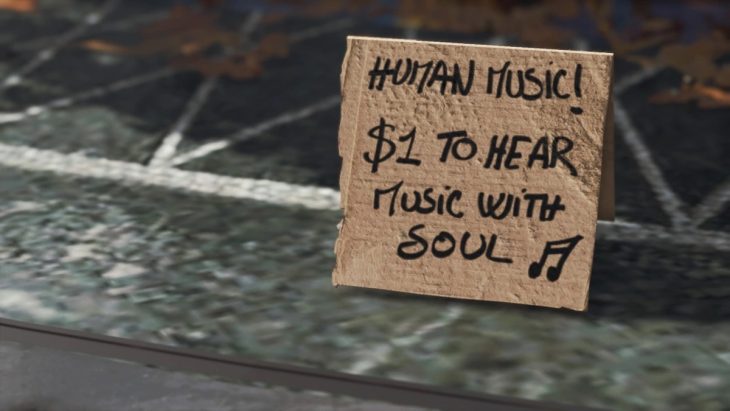 From the game Detroit Become Human – a fantastic exploration of AI what makes a person a person.
From the game Detroit Become Human – a fantastic exploration of AI what makes a person a person.
Television and film aren’t the only way we interact and lean on art.
I cannot tell you the number of times I have been struggling with, well, everything, and unable to find a way to express or clear it away. Then the right piece of music hits, and suddenly I’m a puddle on the floor, or my mind is hijacked and taken on a really impressive adventure. I lean on music a lot for coping with the world. It is even an incredibly important part of my writing process. I have crafted entire novels off a single song (the most recent example would be Skylark, which was written the moment I listened to a song, and then also with that one song on repeat for the three months it took to get that story out onto the page). I have listened to a song, and a critical scene plays out like a movie in my head, guided by the music. The most striking example is this song:
One day, if that story is ever published, I’ll let you all know which scene in particular this song engendered.
Books, of course, including audio books and comics, are other ways the arts create space for us. There are so many reasons and ways literature of all kinds can help. The simplest is a brief escape. I’m no longer me, sitting on the sofa, utterly destroyed by the state of the world. I’m a silent observer; part of adventuring party, or even the main character in another story. And in this story, however high the stakes may be, I am still safe on my sofa. It doesn’t matter what kind of escape. A low stakes, cozy read? Excellent escape. A dire, world-ending threat full of struggle and grief? Excellent escape (and also an opportunity to let those tears out at last). Escape is so important. It’s not forever. And it won’t solve the real-life problems for you.
 Image by Mystic Art Design from Pixabay
Image by Mystic Art Design from Pixabay
But rest is important. If you don’t have a rest day in your workout regime, your muscles will have not time heal, recover and grow. If you do not get adequate sleep, your cognitive function will be severely impacted. It’s no different for your mind/heart. If you don’t take a break from what is causing you distress, you’ll collapse beneath the weight of it all. It’s important to escape. Do it, and don’t feel guilty for it.
Literature also helps navigate terrible situations and scenarios for those of us who struggle with doing so in the real world. It helps give voice, using someone else’s words, to our experiences with enough separation that we remain safe. And sometimes, sometimes it can unlock the tings we need released in order to move forward. I have often been struggling with a completely separate grief, read a particularly tragic incident in a story that has nothing to do with whatever is weighing on me, and then cried. And cried. And cried. Not about the events in the book. But about the situation I’m facing. It’s just that the book helped unlocked the emotions that were trapped behind a dam I didn’t know I had built. Visual media has also helped with this; more with videogames than television shows or films of late, admittedly.
It’s no mistake that nearly all of us turn to the arts when things start going wrong. The arts are important and necessary.
So this is how you survive these interesting times. Consume art.
 Image by Jose Antonio Alba from Pixabay
Image by Jose Antonio Alba from Pixabay
And make it.
I know it’s incredibly difficult to create with the world literally on fire. Or if you’re sick in bed with all the energy of a sloth after a big meal. All the same, human beings are creators by nature. It doesn’t matter what art you create. Or if other people think that art is good. You don’t have to share it at all. It’s just for you. Just create.
That can mean something as simple as buying yourself a colouring book and going to town with crayons or pencils. Hell, even a ball-point pen will work if you’re in a pinch. Got some time between tasks at work? Doodle. Write a short poem. A piece of flash fiction. It doesn’t have to practical. It doesn’t have to be monetized. It does not have to appeal to anyone else. It’s just for you, unless you want otherwise.
If you want, share your art. But that is not required.
It is hard right now. It’s alright if you’re struggling to create. Lord knows, I am. Finding motivation is tough in the current clime. Sometimes I think that’s by design. If you’re too busy trying to stay afloat, how can you imagine anything better for yourself, your neighbours, or the world? So, if anger, frustration and rage is all you have left, use that. Create from that.
Create out of spite.
Create. Make it a giant middle finger to the people who are trying to hold you down, make it hard, steal your joy, stop you from imagining.
Create art. Consume art. It is good for your soul, and the world could use more soul, I feel.
And if you have the means, consider tossing a coin to your Witcher (artist), for their skills have kept the monsters at bay for a little while longer. And in a world full of monsters, that is not nothing.
When S.M. Carrière isn’t brutally killing your favorite characters, she spends her time teaching martial arts, live streaming video games, and cuddling her cat. In other words, she spends her time teaching others to kill, streaming her digital kills, and a cuddling furry murderer. Her most recent titles include Daughters of Britain, Skylark and Human. Her serial The New Haven Incident is free and goes up every Friday on her blog.
“Vanishing Treasures: A Bestiary of Extraordinary and Endangered Creatures” by Katherine Rundell
Dive into Vanishing Treasures, by Katherine Rundell, exploring the delicate balance between cultural heritage and…
The post “Vanishing Treasures: A Bestiary of Extraordinary and Endangered Creatures” by Katherine Rundell appeared first on LitStack.
Teaser Tuesdays - The Queen's Blade

Our realm, splintered and broken, yearned to be united under a single ruler. The Witches may have won and put one of their own on the throne, but even they had suffered.
(page 1, The Queen's Blade by Evelyn Ward)
---------
Teaser Tuesdays is a weekly bookish meme, previously hosted by MizB of Should Be Reading. Anyone can play along! Just do the following: - Grab your current read - Open to a random page - Share two (2) “teaser” sentences from somewhere on that page BE CAREFUL NOT TO INCLUDE SPOILERS! (make sure that what you share doesn’t give too much away! You don’t want to ruin the book for others!) - Share the title & author, too, so that other TT participants can add the book to their TBR Lists if they like your teasers!
THE FURY OF THE GODS by John Gwynne (The Bloodsworn #3)
Spotlight on “The Alchemist of Aleppo” by Marie K. Savage
The Alchemist of Aleppo bends the space-time continuum and embodies our fascination with what science…
The post Spotlight on “The Alchemist of Aleppo” by Marie K. Savage appeared first on LitStack.
Ten Things I Think I Think: January 2025
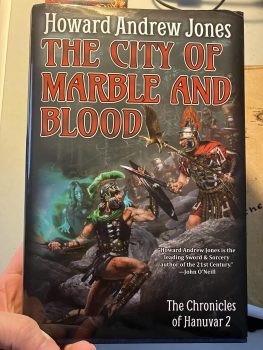 It’s been a whole month since I randomly shared my opinions on things I think How in the world have you made it through the start of this new year, without that????
It’s been a whole month since I randomly shared my opinions on things I think How in the world have you made it through the start of this new year, without that????
So, I think that:
1) THE CITY OF MARBLE AND BLOOD IS TERRIFIC
If you follow me on Facebook – or even read my column here every Monday, you know I’ve been talking about my Black Gate buddy Howard Andrew Jones, who passed away earlier this month. Click on over to see what I had to say last week about a really great guy.
I had not yet read Howard’s most recent trilogy, the Chronicles of Hanuvar. Howard’s Arabian fantasy mystery short stories featuring Dabir and Asim have been my favorites of his work (even more so than the two novels featuring the duo).
But man – this first book in the trilogy is his best work. Incorporating several short stories previously published, it’s very episodic in nature, which I liked. They’re linked together, making up Hanuvar’s ongoing quest, and the format keeps things moving. There’s no padding here.
While I have Robert E. Howard and Fritz Lieber on my shelves, I’m more an epic fantasy fan, ala JRR Tolkien, Terry Brooks, David Eddings, and Robert Jordan. I feel like Howard’s trilogy is epic sword and sorcery – a hybrid of the two which would also include Glen Cook’s The Black Company. It contains the individual adventuring aspect of sword and sorcery (stakes are more focused on the hero, not nations or empires), with the epic story scope of high fantasy. Howard’s trilogy is Epic Sword and Sorcery.
I finished Lord of a Shattered Land, put it on the Shelf, and immediately sat down and began The City of Marble and Blood. And boy, does something big happen by page twenty-five!! The latter two books are in traditional novel form. So be it – I’m in.
2) D&D NOVELS ARE STILL ENJOYABLEI used to own a bunch of the old D&D novels. Series’ such as Ravenloft, The Cleric Quintet, Dragon Lance, Forgotten Realms; dozens of them. I unloaded them during one of my periodic sell-offs over the years (I still have over 2,000 print books, but I’d love to have a lot of the ones which are gone. I still have the Gord the Rogue books, though!
I’ve written about The Temple of Elemental Evil and The Village of Hommlet more than once here at Black Gate. And right now, I’m listening to the audiobook of the ToEE. And it’s not bad.
If you’re looking for a quite D&D-like series, check out the Dhampir books by Rob and C.J. Hendee. They read a lot like a Dungeons and Dragons adventure.
3) JOHN MADDOX’ SPQR MYSTERIES ARE MY FAVESI have now listened to the first ten (of thirteen) of these mystery novels set in Ancient Rome, and I’ve talked about them in What I’ve Been Listening To. I have enjoyed every single of one of these, and John Lee is a PERFECT match as narrator. I can’t imagine anyone else voicing Decius Caecilius Matellus the Younger. I talked about it a little bit, here.
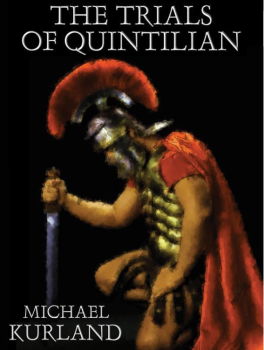 The cover itself is blurry – that wasn’t me!
4) YOU SHOULD CHECK OUT QUINTILIAN TOO
The cover itself is blurry – that wasn’t me!
4) YOU SHOULD CHECK OUT QUINTILIAN TOO
So, if you like SPQR, and you’re looking for more in that vein, check out Michael Kurland’s The Trials of Qunitilain. I’m a fan of Kurland’s Professor Moriarty novels. The Trials of Quintilian contain three stories that use the real-life Marcus Fabius Quintilianus as the hero.
He was an orator, rhetorician, barrister and educator. Here, he’s also essentially a private eye, gathering evidence for the client he is representing as a lawyer. I like the mix of PI and law, set in Ancient Rome. I picked up the ebook at a real steal, and it’s a fun, quick read. More old world Roman mystery stuff for me, please!
5) TOTAL WAR: WARHAMMER II KEEPS DRAWING ME BACKThere are a few games I reinstall every so often (sometimes a couple years apart), dive deep into, then move on. This – and WarHammer I, because combining them lets me play any faction from either game – is far and away my favorite RTS strategy game (it’s properly a hybrid, I think).
But man, I can sink hours upon hours into this. Often having to go back to a prior save and try a different path. While frustrating, it’s still kind of fun to try and make it work out. The first 10 – 15 turns for any faction are always hard for me, and I have a lot of false starts. I don’t actually fight the battles; I auto-resolve them. I like the city and troop building, and the strategies and faction relations. The fantasy aspect of WH makes this far and away my favorite.
They REALLY need to buy the Tolkien license and do TW: Middle Earth. THAT would be fantastic!! I cut my teeth on TW: Rome, and I suspect any Total War game in your interest area (Attila the Hun, Brittania, Egypt – whatever) would work for you. I’m not into Warhammer, but I do like this game.
6) NO WRITING PROJECT IS EVER BEYOND RESUMPTIONI haven’t been writing much lately, beyond my weekly column here (Note to self – quit playing TW: Warhammer II, then!!).
But last week I dusted off a project I started in 2011, and hadn’t worked on for quite a few years, I’m certain. But some real-life downs put me in a frame of mind where it was exactly what I needed to dive into. So, I’m almost done with the first draft of a Companion/Study Guide to Paul’s Letter to the Ephesians. It’s my favorite book of the Bible, and I plan on honing this guide to the sharpness of an obsidian blade.
I had to dig this off a recovered hard drive, it was so dusty. And though I abandoned it over a decade ago, it is thriving right now. No project – even no idea – is ‘dead’ unless you deem it so. And sometimes, an old one just might save you in more ways than one.
7) ANIMAL CONTROL AVOIDS BEING TOO DUMB FUNNYI only watched a couple episodes of Community, though I know about it. Star Joel McHale is the lead on Animal Control, which manages to stay on the side of being good dumb funny. It’s not clever dumb funny, like Galaxy Quest. But it’s not beyond stupid dumb funny, like Dumb and Dumber.
It’s not a thinking-heavy sitcom, but I like it pretty well. I am enjoying it more than Dennis Leary’s Going Dutch, which I haven’t given up on yet. However, Going Dutch doesn’t have much of any any depth to it, so we’ll see how long I can last.
8) I FAILED ON MY ANNUAL CHRISTMAS POST IDEAEvery Christmas (often Christmas Eve), I re-watch Humphrey Bogart’s ‘dark’ comedy, We’re No Angels. And every year, I observe that I really should write a Black Gate post on it. I’m 0 for every year on that. But hey – it’s a new year!!!
A terrific cast and light-hearted dark humor, it’s just about my favorite Christmas movie. Every time I see Peter Ustinov in this, I think that he would have made a good Dr. Watson back then. There was a modern remake (sort-of) with Robert DeNiro and Sean Penn. If that’s the only version you’ve seen, you really should go check out Bogie, Rathbone, and company.
9) I KINDA HAVE A NEW CHRISTMAS FAVE AS WELLThough it’s certainly not ‘new’ anymore, Jingle All the Way is about my favorite modern Christmas movie. It’s a silly (but not too dumb comedy with Ah-nuld Schwarzenegger, Sinbad, and a deliciously creepy Phil Hartman.
I think I’ve added Red One alongside Jingle, after watching it this year. When a Rock movie works, I really enjoy it, and this is like a Marvel-lite Rock Christmas movie. And that’s exactly what I want.
10) I LIKE ONE-OFF CHRISTMAS EPISODES FOR BRITISH TV SHOWSSome British mystery shows I watch, like The Cleaner, and Death in Paradise, air a new episode around Christmas day. I look forward to these now. I actually started a Death in Paradise re-watch after seeing the new Christmas episode (which featured ANOTHER cast change).
We’re talking 109 one-hour episodes, with multiple cast changes. We’re talking quite the investment. I’m almost through season five (of thirteen), and loving every episode. The ‘Christmas episode’ relit a fire. I wrote about the show some, here.
If you’ve seen episode one of season three (and you will absolutely know whether or not you have. A BIIIGGGG thing happened), I wrote an entire post on that one, earlier this month. Do NOT read it if you haven’t seen that episode. Trust me.
Prior Ten Things I Think I Think
Ten Things I Think I Think (December 2024)
Nine Things I Think I Think (October 2024)
Five More Things I Think: Marvel Edition (September 2024)
Ten Things I Think I Think: Marvel Edition ( September 2024)
Five Things I Think I Think (January 2024)
Seven Things I Think I Think (December 2023)
Talking Tolkien: TenThings I Think I Think (August 2023)
A (Black) Gat in the Hand: Ten Things I Think I think (August 2023)
5 More Things I Think (March 2023)
10 Things I Think I Think (March 2023)

Bob Byrne’s ‘A (Black) Gat in the Hand’ made its Black Gate debut in 2018 and has returned every summer since.
His ‘The Public Life of Sherlock Holmes’ column ran every Monday morning at Black Gate from March, 2014 through March, 2017. And he irregularly posts on Rex Stout’s gargantuan detective in ‘Nero Wolfe’s Brownstone.’ He is a member of the Praed Street Irregulars, founded www.SolarPons.com (the only website dedicated to the ‘Sherlock Holmes of Praed Street’).
He organized Black Gate’s award-nominated ‘Discovering Robert E. Howard’ series, as well as the award-winning ‘Hither Came Conan’ series. Which is now part of THE Definitive guide to Conan. He also organized 2023’s ‘Talking Tolkien.’
He has contributed stories to The MX Book of New Sherlock Holmes Stories — Parts III, IV, V, VI, XXI, and XXXIII.
He has written introductions for Steeger Books, and appeared in several magazines, including Black Mask, Sherlock Holmes Mystery Magazine, The Strand Magazine, and Sherlock Magazine.
Bonded in Death – J. D. Robb
 Bonded in Death Series: In Death #60
Bonded in Death Series: In Death #60 on July 30, 2025
His passport read Giovanni Rossi. But decades ago, during the Urban Wars, he was part of a small, secret organization called The Twelve. Responding to an urgent summons from an old compatriot, he landed in New York and eased into the waiting car. And died within minutes…
Lieutenant Eve Dallas finds the Rossi case frustrating. She’s got an elderly victim who’d just arrived from Rome; a widow who knows nothing about why he’d left; an as-yet unidentifiable weapon; and zero results on facial recognition. But when she finds a connection to the Urban Wars of the 2020s, she thinks Summerset―fiercely loyal, if somewhat grouchy, major-domo and the man who’d rescued her husband from the Dublin streets―may know something from his stint as a medic in Europe back then.
When Summerset learns of the crime, his shock and grief are clear―because, as he eventually reveals, he himself was one of The Twelve. It’s not a part of his past he likes to revisit. But now he must―not only to assist Eve’s investigation, but because a cryptic message from the killer has boasted that others of The Twelve have also died. Summerset is one of those who remain―and the murderous mission is yet to be fully accomplished…
GoodreadsPages: 400
Genres: Fiction / Crime, Fiction / Mystery & Detective / General, Fiction / Mystery & Detective / Police Procedural, Fiction / Mystery & Detective / Women Sleuths
Format: Audiobook
Source: NetGalley
ISBN: 9780349443362
Also in this series: Obsession in Death, Devoted in Death (In Death, #41), Down the Rabbit Hole (includes In Death, #41.5), Brotherhood in Death (In Death, #42), Purity in Death (In Death, #15), Apprentice in Death (In Death, #43), Secrets in Death (In Death, #45)
{ "@context":"https://schema.org", "@type":"Review", "datePublished": "2025-01-27T05:39:36+00:00", "description": "\nAnother great novel from J. D. Robb. \u00a0These books are one of a few series that I can enjoy hearing and not reading myself. \u00a0You will miss much of the story if you haven't read the previous boo", "publisher": { "@type": "Organization", "name": "Books In Brogan" }, "url": "https:\/\/booksinbrogan.com\/blog\/2025\/01\/26\/bonded-in-death-j-d-robb\/", "itemReviewed": { "@type": "Book", "name": "Bonded in Death", "author": { "@type": "Person", "name": "", "sameAs": "" }, "isbn": "9780349443362" }, "author": { "@type": "Person", "name": "Books In Brogan", "sameAs": "https:\/\/booksinbrogan.com\/" }, "reviewRating": { "@type": "Rating", "ratingValue": false, "bestRating": "5" } }
Another great novel from J. D. Robb. These books are one of a few series that I can enjoy hearing and not reading myself. You will miss much of the story if you haven’t read the previous books. The author usually writes books that may have a little back story but this one has a lot of links to previous books and you would need the previous book to solve the murder mystery.
An Eternal Champion’s Legacy: 64 Years After his Debut, Fantasy’s Original Edgelord Still Reigns Supreme
Paperback editions of the first six Elric books (DAW Books, 1972 – 1977). Covers by Michael Whelan
It may not seem like it, but this winter has given fans of fantasy plenty to celebrate. Less than a month ago, Michael Moorcock turned 84, his most recent Elric novel turned three, and the latest reprint of his vaunted Eternal Champion series hit store shelves in the US. Thanks to a boatload of new collections, there is no better time to be a fan of the pale emperor. Or, for that matter, to look into his legacy.
Suffice to say that Moorcock’s legendary career has been full of incredible characters. His influence can be seen among the finest rogues of the Sword Coast and in tales spun in the far-flung wine sinks of Essos. Nowhere is that more noticeable than with his most famous creation, Elric of Melnibone. When his early stories made their way into the hands readers in the 60s and 70s, the impact would prove seismic. Today those same readers are academics, authors, and gamers happy to see Elric influence another generation.
[Click the images for Champion versions.]
“It stuck out from any other fantasy book I’d read,” Derik Petrey shared the moment Elric of Melnibone was brought up.
The Chair of Humanities at Sinclair Community College recalls that first encounter with the emperor of dragon isle vividly. Like so many other readers in the 80s, Moorcock’s style and characters proved as addictive Imrryr’s dream couches.
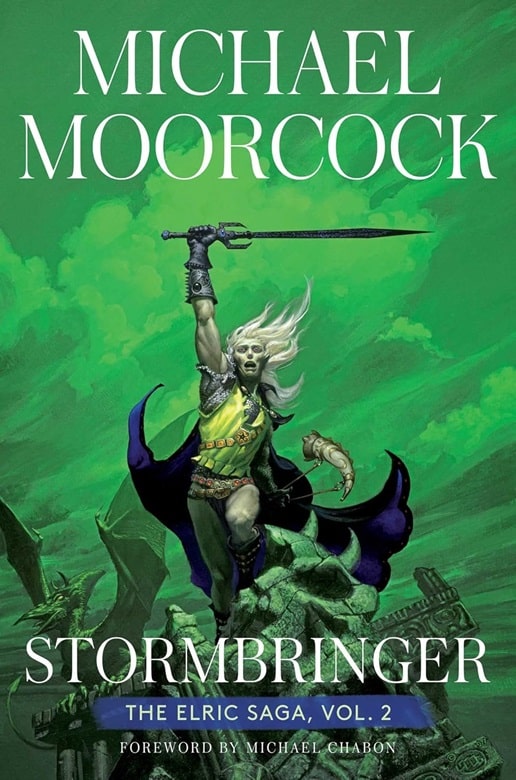
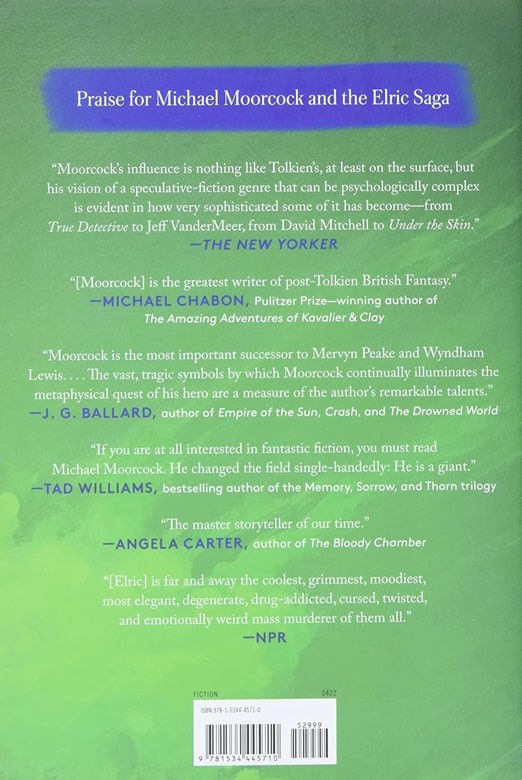
The Elric Saga, Volume 2: Stormbringer , an omnibus containing the novels
Stormbringer (1965), The Vanishing Tower (1977), The Bane of the Black Sword (1977),
and The Revenge of the Rose (1991). Saga Press, April 12, 2022. Cover by Michael Whelan
“He was really the first antihero that I’d read and could wrap my head around. There was this sense that ‘oh this person has all sorts of flaws.’ He’s addicted to drugs, longs to marry his cousin, and keep her from her brother,” Petrey remembered.
The years 1983-1984 would see him read Elric of Melnibone and The Sailor on the Seas of Fate. In an age where the works of JRR Tolkien and CS Lewis were the example other authors followed, Moorcock became a patron saint of literary rebels.
“He (Elric) did not have the values of a Tolkien-esque character. You have his dependency on a sword, a living weapon, and also this love-hate relationship with Arioch that was really uncommon.”
Sci-fi fans of Petrey’s vintage look around and see a landscape transformed by the pale swordsman. Other Eternal Champions were great characters, but to Petrey, neither Corum, Dorion Hawkmoon, or any of the others held a candle to Elric.
“It was very much conveyed to me that this was a non-human civilization. It’s this idea of how you communicate how different a society would be,” Petrey said. “There were very few science fiction writers that treated aliens as truly alien. You had Jack Vance, Larry Niven, and Moorcock.”
Elric’s modern-day revival speaks to the enduring power of Moorcock’s writing. Recent years have seen entirely new generations of readers take to the original White Wolf of Fantasy.
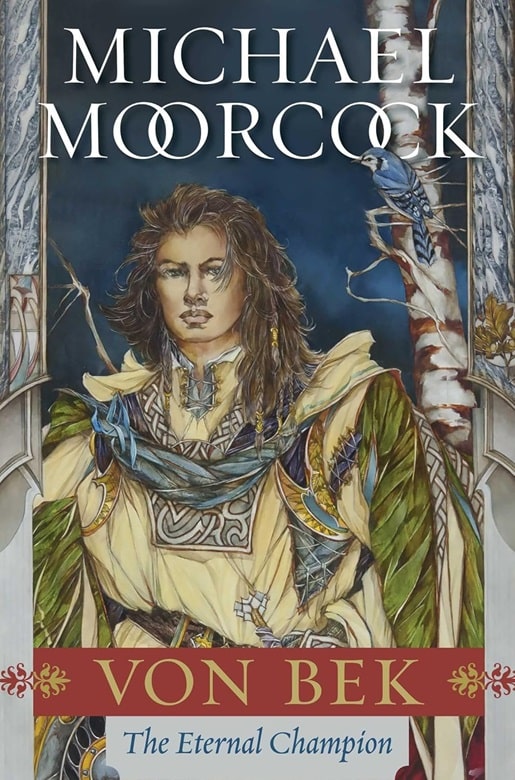

Von Bek: The Eternal Champion omnibus, containing The Warhound and the World’s Pain
and The City in the Autumn Stars (Saga Press, December 3, 2024). Cover by Tom Canty
It wasn’t so long ago that simply finding certain editions of the Elric saga were a challenge. The number of anthologies, collections, and iterations of his stories can be staggering. Untangling the publication history of Elric for this article left me bewildered at times. Without the recent wave of reprints, reading those stories would be just as much of a challenge.
That would change in 2022. Starting in Feb. of that year, Saga Press announced they would be releasing new collections of Moorcock’s work starting with the Kinslayer himself. Last December, fellow Eternal Champion Von Bek received the same loving treatment when The Warhound and The World’s Pain returned to bookshelves. The well-made collections have made the jobs of Booktubers peddling the proverbial Book of Elric that much easier.
“I think Elric’s sustained popularity over more than 60 years owes much to Moorcock’s transgressive bent. He upended, or amplified beyond convention, traditional tropes of speculative fiction, including the monomyth (the hero’s journey),” Bridger, from the Library Ladder YouTube channel, shared by email.
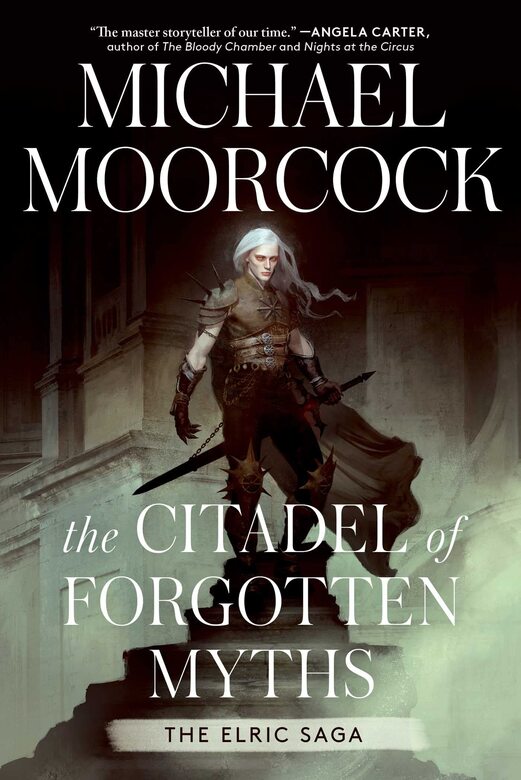
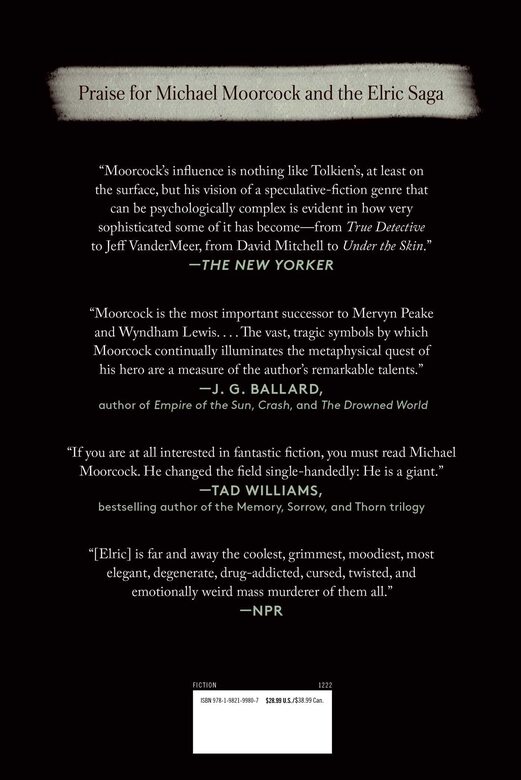
The Elric Saga: Citadel of Forgotten Myths (Saga Press, December 6, 2022). Cover by Bastien Lecouffe-Deharme
He is one of many helping introduce Elric and his fellow champions to readers online. His four Moorcock-specific videos alone have garnered over 160,000 views.
At just 12, he would begin his journey alongside Imrryr’s most famous citizen with the DAW paperback editions, with their beautiful Michael Whelan covers. Completing the first Thomas Covenant Trilogy — Lord Foul’s Bane, The Illearth War, and The Power That Preserves — would serve as good preparation for Elric.
“Elric and Covenant seemed almost like two sides of the same coin. Both were moody, morally ambiguous, endowed with awesome powers they feared, and prone to occasional outbursts of primal, uncontrolled violence. But I found Elric less abrasive, easier to identify with, and more willing to take decisive action when situations called for it. They were significant departures from any heroic characters I’d encountered up to then,” Bridger explained.
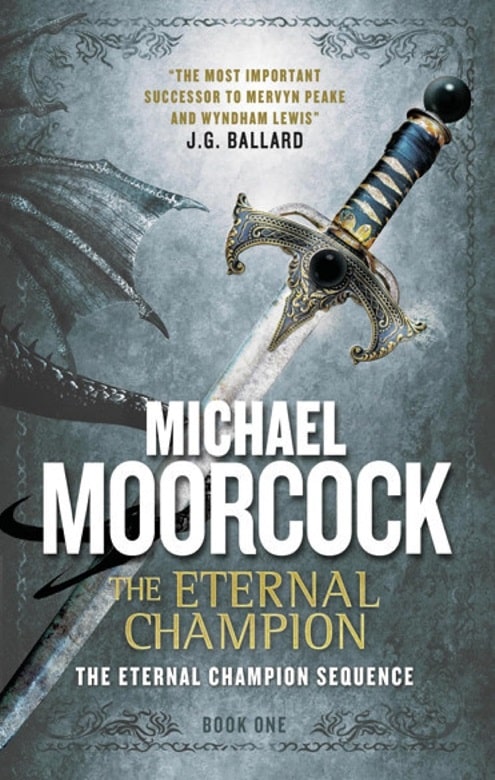
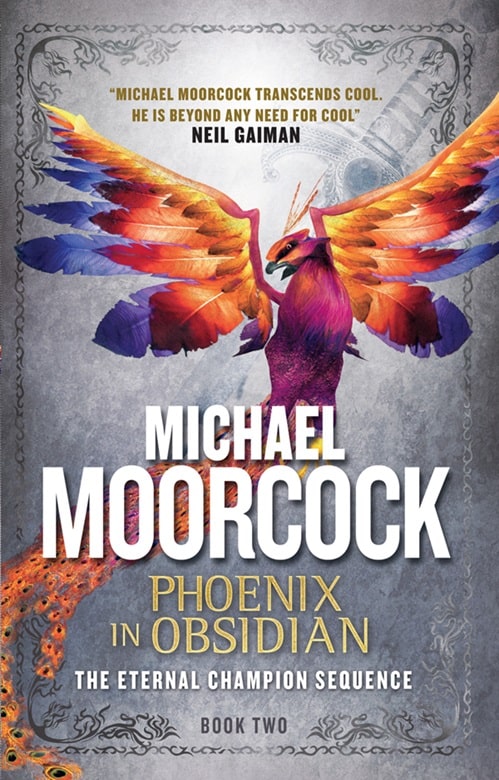
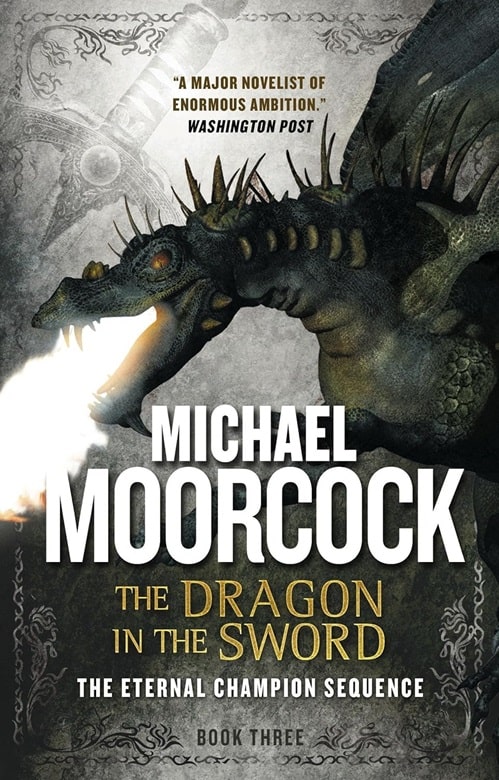
The Eternal Champion Sequence: The Eternal Champion, Phoenix in Obsidian, and
The Dragon in the Sword (Titan Books, November 2014). Covers uncredited
Like many readers, Bridger would return to the classic character time and again. Moorcock’s remarkable ability to churn out one story after another helped keep Elric current and fresh.
“In Elric, Moorcock took many of those qualities to extremes relative to typical fantasy heroes. His moods are darker. His weaknesses more debilitating. His impulses more consequential. His betrayals and revenges more bloody. And the stakes are higher, as he strives to save not just one world, but an entire multiverse of them,” Bridger shared.
He sees Elric’s legacy across the genre and beyond. And it is a legacy not just limited to books. His influence can be seen in video games, on tabletops, big and small screens.
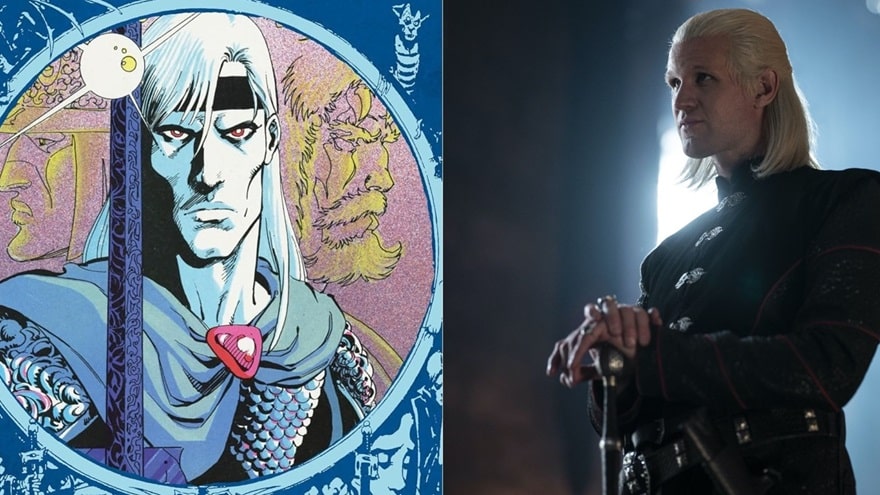 Elric and House of the Dragon‘s Daemon Targaryen. Art by Jan Duursema, from The Michael Moorcock Library Vol. 5: Elric The Vanishing Tower (Titan Comics, August 8, 2017). Daemon Targaryen photo by Ollie Upton.
Elric and House of the Dragon‘s Daemon Targaryen. Art by Jan Duursema, from The Michael Moorcock Library Vol. 5: Elric The Vanishing Tower (Titan Comics, August 8, 2017). Daemon Targaryen photo by Ollie Upton.
“There are some obvious parallels between Elric and later albino characters in fantasy fiction such as R.A. Salvatore’s drow elf Drizzt, Andrei Sapkowski’s Geralt the Witcher, and several members of George R.R. Martin’s Targaryen family tree, with their special abilities and complicated personalities,” Bridger detailed, explaining that the albino trope was itself borrowed from Sexton Blake’s Monsieur Zenith.
Roland Deschain of Stephen King’s Dark Tower series and Tyrion Lannister from A Song of Ice and Fire are two other characters that remind Bridger of the Eternal Champion. For Petrey, its Death from The Sandman that reminds him most of Elric. Both see the industry as being much richer due to the author’s influence.
“There’s an authenticity in Moorcock’s work. He himself is an iconoclast, he loves taking conventions and smashing them and I think that’s refreshing every once in awhile,” the professor stated.
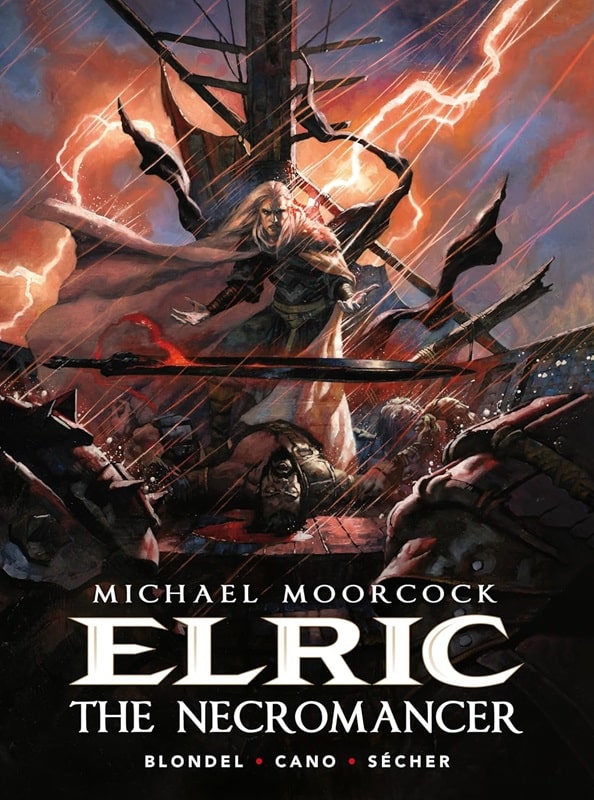 Michael Moorcock’s Elric Volume 5: The Necromancer, written by by Julien Blondel and illustrated by Valentin Sécher (Titan Comics, December 31, 2024).
Michael Moorcock’s Elric Volume 5: The Necromancer, written by by Julien Blondel and illustrated by Valentin Sécher (Titan Comics, December 31, 2024).
A six-decade run doesn’t happen by accident. If Elric proves anything, it’s that with the pale prince of ruins Moorcock was able to capture the magic that continues to enchant lovers of the genre.
“These are characters that have their own lives. I don’t want to be like Elric but his stories help me imagine what living that life, at that time, and in those societies would be like,” Petrey said.
The DNF Round-Up
As all readers know, sometimes a book just doesn’t click. Maybe it’s just not what you expected—or worse, maybe it’s just not working for you at all. Granted, it doesn’t happen to me too often, but when it does, that’s when DNF reviews come in. I’ve found that it greatly helps me process my reading experience to articulate why a book didn’t work for me, not to mention they also serve as a way to share my honest opinions with other readers who might feel the same—or who might actually enjoy the book for the very reasons I didn’t.
Here are the latest books that didn’t quite hit the mark for me and that I ultimately decided to put aside (a couple of these were actually from the tail end of last year).
I received review copies from the publisher(s). This does not affect the contents of my reviews and all opinions are my own.
 All the Hearts You Eat by Hailey Piper
All the Hearts You Eat by Hailey Piper
Mogsy’s Rating: DNF
Genre: Horror
Series: Stand Alone
Publisher: Titan Books (October 15, 2024)
Length: 447 pages
From the start, this one felt off to me. The prose was overly flowery and purple, making the writing feel bloated with unnecessary words. It’s tough to explain, but the intro felt simultaneously drawn out and all over the place. It was also hard to care about the characters, and by the time I set the book down about a quarter of the way into the book, they still didn’t feel fully realized. Any message on solidarity and friendship was completely overshadowed by the book’s aimless structure. Simply put: too many POVs, too much chaos, and too much pointless rage made this one impossible to continue.
 American Rapture by C.J. Leede
American Rapture by C.J. Leede
Mogsy’s Rating: DNF
Genre: Horror
Series: Stand Alone
Publisher: Nightfire (October 15, 2024)
Length: 384 pages
American Rapture had such an intriguing premise: as a new virus spreading across the country making the infected feral with lust, our protagonist braves the unknown to reunite with her family. Problem is, the author is not known for sublety. Really, she is not. Being over the top and shocking is part and parcel of the style and experience. But when you are dealing with such weighty topics like spiritual wounds, conflicted identities, and societal collapse, this treatment just feels so gratuitous and flippantly distasteful. This book didn’t feel like a story; the character felt more like Leede’s mouthpiece to deliver a one-sided and heavy-handed screed, and I abandoned ship early when I realized where things were headed.
 Water Moon by Samantha Sotto Yambao
Water Moon by Samantha Sotto Yambao
Mogsy’s Rating: DNF
Genre: Fantasy, Romance
Series: Stand Alone
Publisher: Del Rey (January 14, 2025)
Length: 384 pages
I really really wanted to like this book. That I didn’t DNF it until well after the 50% mark should tell you just how badly I tried, but ultimately it wasn’t to be. With all the comparisons to Studio Ghibli, I was originally all on board, but as any fan knows, their films are diverses in tone and not all of them resonate with everyone. Sadly, while Water Moon had the whimsy and mythological charm down pat, it fell short in the areas that matter most to me: character development and cohesive storytelling. Troubles began with the clunky and overwrought writing style, and further issues came to light when the plot made it more important to focus on the romance. It’s a shame because I wanted to be swept away by the magic but instead I was left disappointed, though Water Moon will undoubtedly be a favorite for many.
What a Croc, Part I
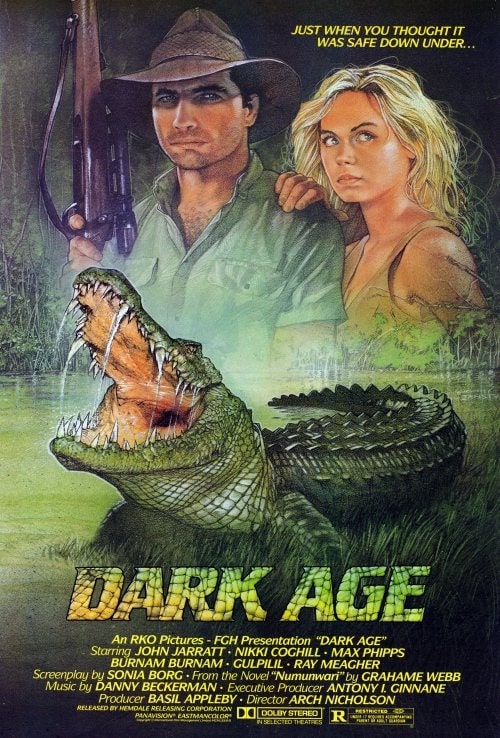 Dark Age (Embassy Home Entertainment, July 10, 1987)
Dark Age (Embassy Home Entertainment, July 10, 1987)
My next watch-a-thon is a favorite genre: crocs and gators. Unfortunately, this means the pickings are a bit slim, as I’ve already seen most of them, but I’ve managed to dig up 15 so far (supplemented with a Gila Monster and a couple of Komodos), and I’m sure the intended list of 20 will materialize as streaming services start suggesting titles.
Dark Age (1987) YouTubeCroc or gator? A 25ft saltwater crocodile.
Real or faker? A lovely, animatronic behemoth.
Any good? A thoroughly decent offering from the Ozploitation market, Dark Age is far from a mindless bloodbath sprinkled with spring breakers, and instead does what most Australian horror does: provide thrills alongside a biting social commentary. The croc in question is Numunwari, considered a God by the local Aboriginal population, but the extremely unpleasant white folks just see it as a trophy for their walls. Doubly so after it kills several people (including a rather unsettling attack on a young child).
The only decent non-Aboriginal character is Steve Harris, a conservationist, played by John Jarrett (who would go on to sever spinal cords 18 years later in Wolf Creek). He strives to find a way to stop the croc without killing it, and so begin the saltwater shenanigans. It’s well made, speckled with nods to Jaws throughout, and apparently a favorite of Tarantino’s. Loved it –- off to a great start!
8/10
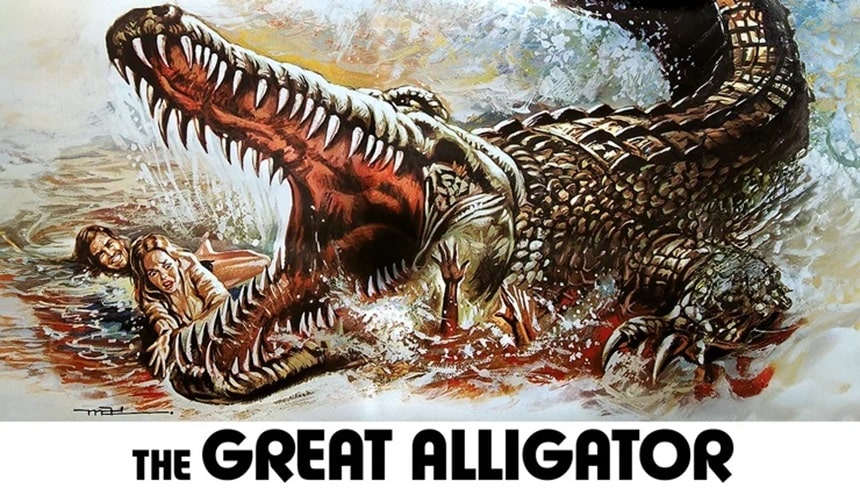 The Great Alligator (Medusa Distribuzione, November 1979)
The Great Alligator (1979) YouTube
The Great Alligator (Medusa Distribuzione, November 1979)
The Great Alligator (1979) YouTube
Croc or gator? Actually a crocodile.
Real or faker? A big ol’ chonky puppet.
Any good? Warning: being a late 70s Italian ‘shocker’, this film kicks off with a bit of animal cruelty (not on the level of of a Deodato film though) and plenty of bare norks.
That said, it’s an enjoyable romp, backed up with a funky bongo soundtrack, and starring Mel Ferrer and Barbara Bach (dubbed throughout, even though the film is in English). The film concerns another croc God, this time an African one (the film was actually shot in Sri Lanka and features wildlife stock footage from Borneo).
Like Dark Age, the film concerns itself with more than just an angry reptile; environmentalism, colonialism and capitalism are all thoroughly speared (literally). There’s a great deal of ‘white savior vs. the savages’ going on, but it’s not too ugly, and all the racists get a decent comeuppance. The giant croc itself is astonishingly tame, more of a pool floaty than a killing machine, but it does chew the shit out of a VW camper van, so I applaud its efforts. I had fun.
7/10
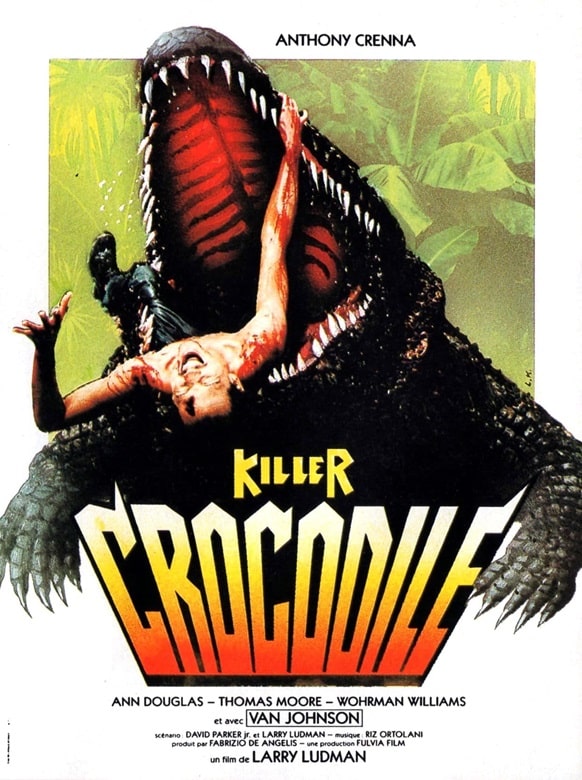
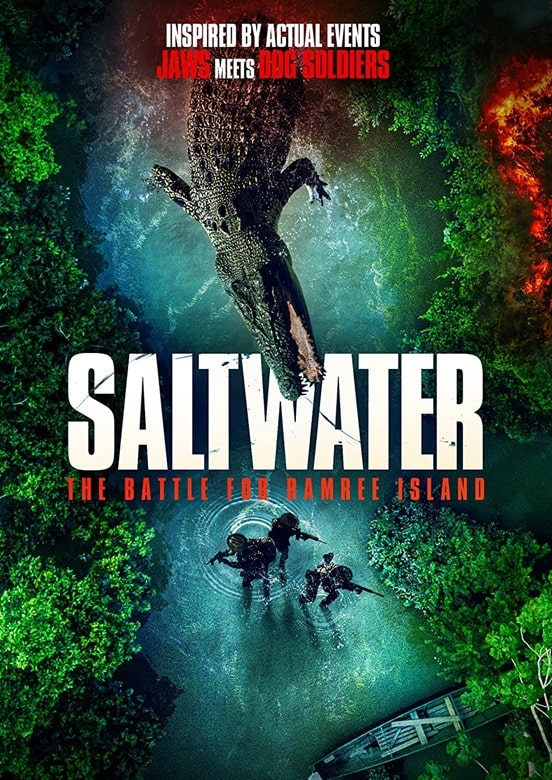
Killer Crocodile (Fulvia Film, July 30, 1989) and Saltwater: The Battle for Ramree Island (Creativ Studios, June 1, 2021)
Croc or gator? Crocodile.
Real or faker? A hilarious puppet.
Any good? Another Italian production to join the plethora of Jaws rip-offs, and another similar plot. This time a group of peace-loving tree-huggers are in an unspecified locale (actually the Dominican Republic) to investigate a polluted river. The toxic waste is not only bad for fish but bad for humans, as it has mutated a croc into a canvas coated styrofoam puppet that eats everything it sees with its googly eyes.
Cue some more white saviors saving the dark-skinned locals, a corrupt baddie getting his comeuppance and Lee Van Cleef-Lite jumping on the back of the titular beast and surfing it under the waves. A bit of good gore, a lot of bad acting and a soundtrack that sounds like the producer’s uncle farting into a tuba. Solid euro-trash. I liked it.
6/10
Saltwater: The Battle for Ramree Island (2021) PrimeCroc or gator? Crocodile(s).
Real or faker? Stock footage and a hand puppet…
Any good? Burma, 1945. Stories are told of a Japanese base on the island of Ramree that was overrun by saltwater crocodiles, leaving only 20 men alive out of a total of 1000. It’s based on fact, but the numbers have been wildly exaggerated.
That said, it would make a really interesting film as told from the Japanese point of view. Instead, we get a low-budget snooze-fest that could only afford two Japanese actors after shelling out for its four principal cast members. An inept squad of British soldiers (including one from the 77th Indian Infantry Brigade) are on a secret mission. So secret that three of them don’t know why they are there.
This squad makes Dad’s Army look like the S.A.S. — terribly written, 2-dimensional cliches (the befuddled old sergeant, a racist private, the quiet one (actually called Private Pike) and a very nice Indian) — and they soon find themselves up to their chewed knees in crocs. Way too much talking, not enough chomping.
Don’t believe that tagline. Dull.
5/10
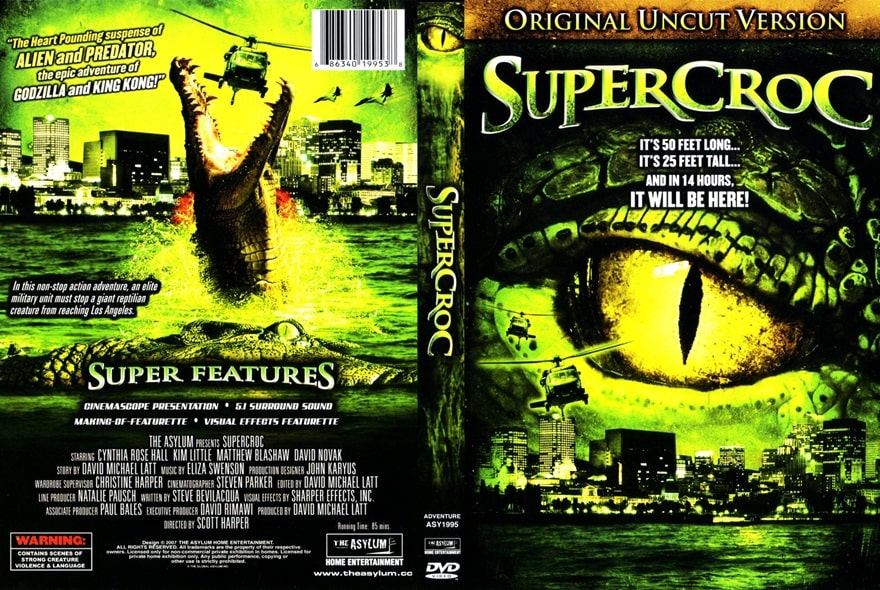 Supercroc (The Asylum, April 3, 2007)
Supercroc (2007) Tubi
Supercroc (The Asylum, April 3, 2007)
Supercroc (2007) Tubi
Croc or gator? Crocodile.
Real or faker? Terrible CG.
Any good? I’m dragged kicking and screaming back to the reality of low budget crap by this one from 2007. Horribly shot (all extreme close ups or unfocused wobbly-cam), Supercroc is about a less-than-super crocodile that has decided to lay some eggs and go on the rampage. The US military machine (a bunch of soldiers in a park) try to stop it and mostly get eaten.
It’s dull, full of mismatched military stock footage, and the CG is abysmal — case in point, the 50ft reptile slides into the water with nary a ripple. Not good.
3/10

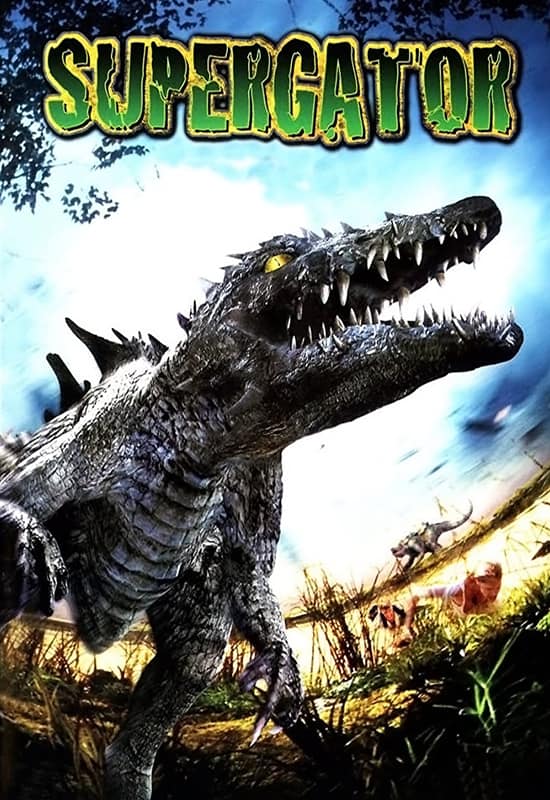
Crazy Tsunami (Splendid Film, 2021) and Supergator (Rodeo Productions, 2007)
Croc or gator? Crocodile.
Real or faker? Combo CGI and floaty puppet.
Any good? A Chinese production, keeping their recent fondness for glossy monster movies on the boil, this one is obviously inspired by the brilliant Crawl and the equally fun Aussie shark flick, Bait. In it, a freak tsunami in Indonesia floods Chinatown, and leaves a group of survivors fending off an African crocodile, which was being transported to a private collection.
Throw in some unscrupulous building developers, and you have a recipe for extremely moist mayhem. It’s derivative and hokey, and yet I really enjoyed it. Might be my favorite so far.
7/10
Supergator (2007) YouTubeCroc or gator? Alligator. Sort of.
Real or faker? Rubbish CGI.
Any good? Nope. Hot on the heels of Dinocroc, Roger Corman wanted to make a sequel, but SyFy said no. So he made it anyway, tweaked the monster design, had a nice few weeks in Hawaii, and produced this bit of tripe.
Kelly McGillis is the big name in this one, and she suffers through a tired script, hokey acting and lousy effects. It’s hard to judge a film like this, I’m not watching it for plot or character development and I guess if I was a 15-yr-old horndog I could grade the knocker quota, but in the end all I can ask is: was I entertained?
No, I wasn’t.
4/10
Previous Murkey Movie surveys from Neil Baker include:
Prehistrionics
Jumping the Shark
Alien Overlords
Biggus Footus
I Like Big Bugs and I Cannot Lie
The Weird, Weird West
Warrior Women Watch-a-thon
Neil Baker’s last article for us was Prehistrionics, Part III. Neil spends his days watching dodgy movies, most of them terrible, in the hope that you might be inspired to watch them too. He is often asked why he doesn’t watch ‘proper’ films, and he honestly doesn’t have a good answer. He is an author, illustrator, outdoor educator and owner of April Moon Books (AprilMoonBooks.com).
The Push and Pull of Desire in “Far From the Madding Crowd” Plus “The Past is Red”
Far From the Madding Crowd, by Thomas Hardy First published in 1874, Hardy’s Far From…
The post The Push and Pull of Desire in “Far From the Madding Crowd” Plus “The Past is Red” appeared first on LitStack.
THE OUTCAST MAGE by Annabel Campbell
The Teller of Small Fortunes - Book Review
 The Teller of Small Fortunesby Julie Leong
The Teller of Small Fortunesby Julie LeongWhat is it about:Tao is an immigrant fortune teller, traveling between villages with just her trusty mule for company. She only tells "small" fortunes: whether it will hail next week; which boy the barmaid will kiss; when the cow will calve. She knows from bitter experience that big fortunes come with big consequences…
Even if it’s a lonely life, it’s better than the one she left behind. But a small fortune unexpectedly becomes something more when a (semi) reformed thief and an ex-mercenary recruit her into their desperate search for a lost child. Soon, they’re joined by a baker with a knead for adventure, and—of course—a slightly magical cat.
Tao sets down a new path with companions as big-hearted as her fortunes are small. But as she lowers her walls, the shadows of her past are closing in—and she’ll have to decide whether to risk everything to preserve the family she never thought she could have.
What did I think of it:This is such a good read!
I will confess I fell in love with the cover, and that's why I bought tis book. It turned out to be a Cozy Fantasy: as if your read is giving you a hug by being mostly nice, comforting, and happy.
I loved Tao and the people she meets and befriends. Especially Mash, the ex-mercenary is so awesome (and bearded mostly, although he should stop shaving entirely Voodoo Bride wants me to add).
There are of course some stakes to keep everyone moving, but I never worried, trusting that this book wouldn't disappoint me by suddenly being mean to me.
All in all a wonderful read, and I immediately bought an extra copy to gift a good friend for her birthday (because nobody gets to borrow mine!).
Why should you read it:Cozy Fantasy! So nice and huggable!
Goth Chick News: The Hairy Problem of Werewolf Movies
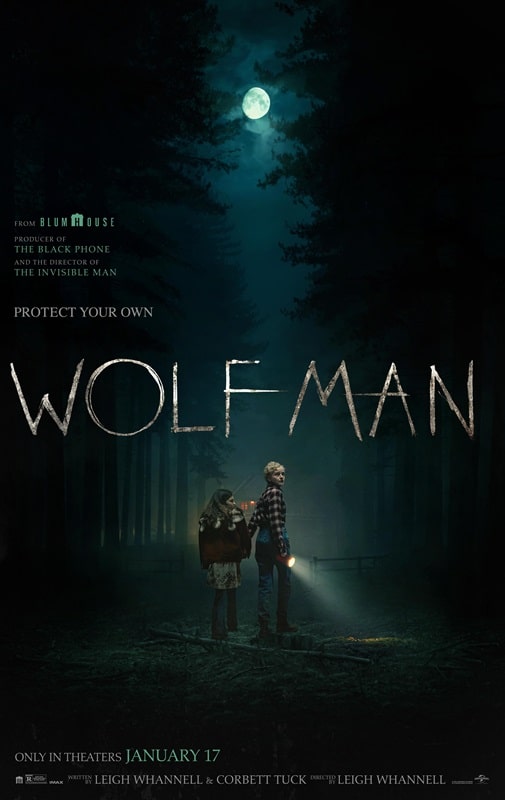 Wolf Man (Universal Pictures, January 17, 2025)
Wolf Man (Universal Pictures, January 17, 2025)
Why oh why can’t Hollywood produce a decent werewolf movie?
I’ve had my heart broken twice in the past few months, first by The Beast Within (2024) and most recently by Wolf Man (2025).
I first told you about The Beast Within starring Kit Harington, back in August. In summary, it was lousy. Though the trailer implied a suspenseful, cohesive tale, Beast was a rambling affair that didn’t seem to know what it wanted to be. As for an actual werewolf transformation, it was implied but never really materialized. Instead, director Alexander J. Farrell tried to distract us from this fact with a knee-jerking series of events that barely held together as a story. Even putting Harington half-naked in a dog collar wasn’t enough to make me forgive this mess.
So, if you tell me I should have known better when, with renewed hope, I ran off to the theater last weekend to see Wolf Man, I wouldn’t argue.
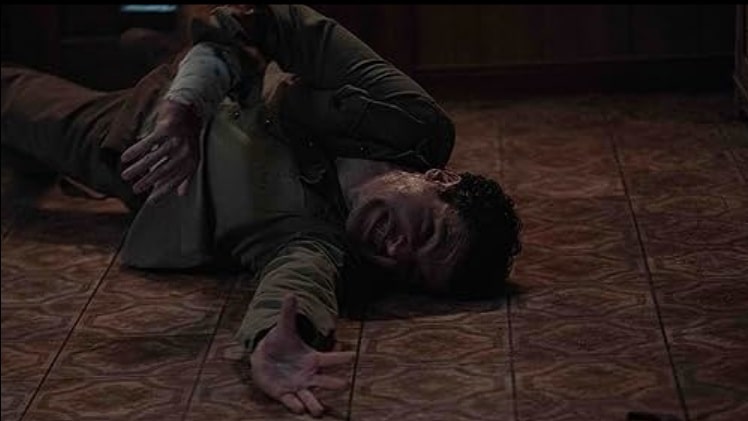 Wolf Man
Wolf Man
Making another attempt at revitalizing the classic monsters franchise ahead of opening its “Dark Universe” park in May, Universal Studios got behind this werewolf movie produced by Blumhouse, which made me think there was a chance it would be good. Afterall, it was Jason Blum who inspired Universal to give their Dark Universe movie franchise another go after Tom Cruise’s The Mummy was an unmitigated atrocity.
Universal had scrapped all the big-budget monster remakes they had teed up, which was more than fine with most fans, including me. Then here comes indie production company Blumhouse, hitting a home run with The Invisible Man (2020). Making nearly $145M on a $7M budget that’s a 20x return, meaning Hollywood couldn’t throw new projects at Jason Blum fast enough. When I heard Blumhouse had been handed the remake of Wolf Man (1941) I dared to be cautiously optimistic.
What a mistake.
I can count on one hand the number of times I’ve sat in a theater looking at my watch. I nearly always find something to love about most movies, but Wolf Man was so awful I would have got up and left had it not been for the tiny flame of hope I had that maybe the ending would redeem my two-hour investment.
It didn’t.
Here’s how Universal described Wolf Man:
Golden Globe nominee Christopher Abbott (Poor Things, It Comes at Night) stars as Blake, a San Francisco husband and father, who inherits his remote childhood home in rural Oregon after his own father vanishes and is presumed dead. With his marriage to his high-powered wife, Charlotte (Emmy winner Julia Garner; Ozark, Inventing Anna), fraying, Blake persuades Charlotte to take a break from the city and visit the property with their young daughter, Ginger.
But as the family approaches the farmhouse in the dead of night, they’re attacked by an unseen animal and, in a desperate escape, barricade themselves inside the home as the creature prowls the perimeter. As the night stretches on, however, Blake begins to behave strangely, transforming into something unrecognizable, and Charlotte will be forced to decide whether the terror within their house is more lethal than the danger without.
Sounds promising right? And for the first 20 minutes or so it kind of was. The dialog was lame, but the premise was interesting. En route to the childhood home in the middle of nowhere, the family gets into an accident and as they extricate themselves from the wreckage, the dad is bitten by an animal that runs off before they get a good look. Que the slow transformation of the dad into a werewolf which could have been awesome but instead was so drawn out and mind-numbingly boring it made me angry.
And come on – we had two fabulous werewolf movies back in the 80s in the form of The Howling (1981) and American Werewolf in London (1981), so someone in Hollywood must have kept the instructions on how to create a credible werewolf transformation with practical effects.
 Wolf Man
Wolf Man
But no. Wolf Man not only failed in its plot and dialog, but it utterly and completely defecated the mattress in creating an even remotely interesting werewolf.
So why does Hollywood keep getting werewolves wrong? The answer might lie in their complexity. Werewolves require nuance, and filmmakers seem allergic to it. Moreover, there are considerable technical challenges of depicting a werewolf convincingly. While CGI can be incredible, the extreme overuse of computer effects has resulted in a bit of audience backlash, causing filmmakers to go back to practical effects which clearly can’t keep pace with a modern audience’s expectations.
Finally, there’s a lack of fresh ideas. Perhaps it’s time for filmmakers to take inspiration from outside the box—or at least hire a scriptwriter who doesn’t think “lycanthropy” is just a fancy word for mood swings.
Despite these missteps, there’s still a tiny glimmer of hope for us werewolf fans. Enter Robert Eggers, the visionary director behind Nosferatu (which I’ve seen multiple times and absolutely loved – more on that next week). Eggers has announced his next project, Werwulf, will be a period horror film that promises to blend folklore, psychological terror, and meticulously crafted visuals into the ultimate werewolf tale.
Fans of Eggers know his penchant for historical authenticity and atmospheric storytelling, which could make Werwulf the fresh take that the genre desperately needs. With Eggers at the helm, there’s genuine hope that audiences will finally get a werewolf film that balances primal horror with emotional depth.
Hollywood, the ball’s in your court. But for now, maybe leave the werewolves alone for a bit. They deserve a better cinematic fate than what they’ve had recently.
The Sword and Planet of Edgar Rice Burroughs, Part I
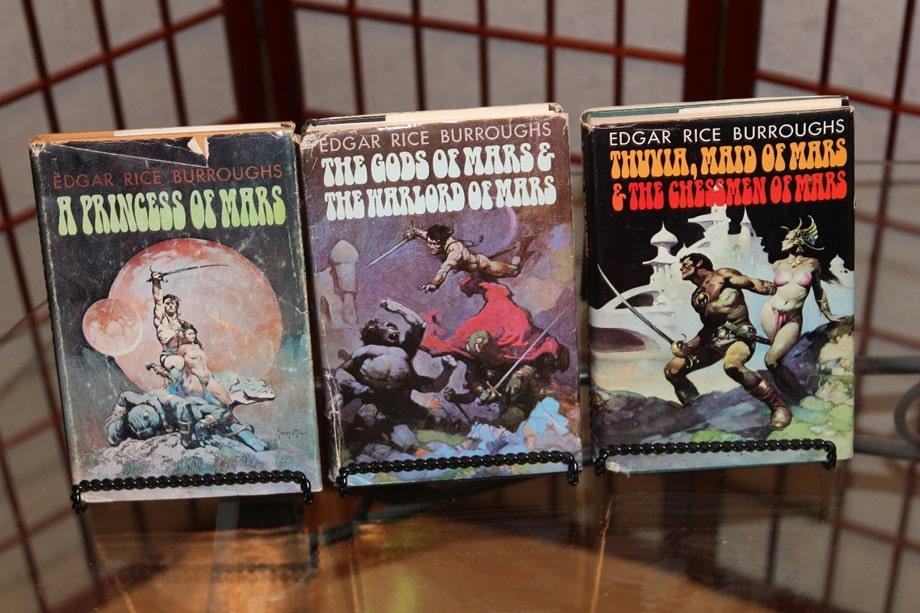 Edgar Rice Burroughs’ Barsoom novels: A Princess of Mars, The Gods of Mars and The Warlord of Mars, and Thuvia, Maid of Mars and The Chessmen of Mars (Science Fiction Books Club, July 1970, January 1971, and January 1973). Covers by Frank Frazetta
Edgar Rice Burroughs’ Barsoom novels: A Princess of Mars, The Gods of Mars and The Warlord of Mars, and Thuvia, Maid of Mars and The Chessmen of Mars (Science Fiction Books Club, July 1970, January 1971, and January 1973). Covers by Frank Frazetta
For sheer fun and adventure there’s nothing better in my opinion than Sword & Planet fiction (also called Interplanetary Adventure, Interplanetary Romance, or Planetary Romance). But exactly what is Sword & Planet fiction? Well, Edgar Rice Burroughs (ERB) created the prototype in 1911 with A Princess of Mars, which featured an Earthman named John Carter who is mysteriously transported to Mars, called Barsoom by its inhabitants.
The basic Sword & Planet story involves an earthman (rarely an earthwoman up to this point in time; 2025) on a strange world where he must use his wits, his muscles, and his sword against a host of human and nonhuman foes. The hero is generally chivalrous and the setting is an exotic alien world, often with multiple suns or multiple moons, populated by a variety of strange plants, animals, and intelligent beings. Magic is virtually non-existent, but there may be elements of “super-science,” such as open-decked flying ships or even ray-guns, although the latter take second billing to the blade. The emphasis is on swashbuckling sword fights, wild escapes, and desperate rescues.
[Click the images for Mars-sized versions.]
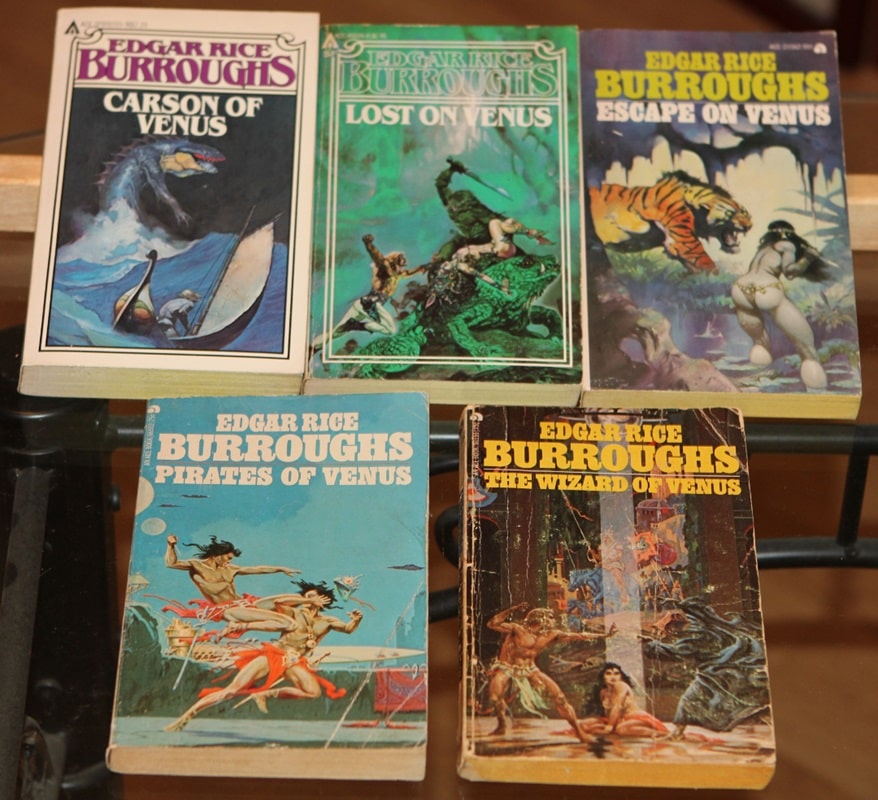 Edgar Rice Burroughs’ Venus novels: Carson of Venus, Lost on Venus, Escape on Venus, Pirates of Venus, and The Wizard of Venus (Ace Books, June 1979, June 1979, January 1974, March 1973, and January 1973). Covers by Frank Frazetta, Esteban Maroto, Frazetta, Roy G. Krenkel, and Roy G. Krenkel
Edgar Rice Burroughs’ Venus novels: Carson of Venus, Lost on Venus, Escape on Venus, Pirates of Venus, and The Wizard of Venus (Ace Books, June 1979, June 1979, January 1974, March 1973, and January 1973). Covers by Frank Frazetta, Esteban Maroto, Frazetta, Roy G. Krenkel, and Roy G. Krenkel
In addition to the Barsoom books, ERB also wrote a second Sword & Planet series, five books set on Venus (Amtor to the natives), featuring the earthman Carson Napier. Napier is intending to fly a rocket ship to Mars but ends up crashing on cloud-covered Venus.
He finds a world of giant trees and strange creatures, and, of course, a princess. Her name is Duare. Like Barsoom, Amtor mixes the primitive with super science, but the emphasis is on action, adventure, and personal combat with edged weapons.
 Escape on Venus, The Moon Men, Pirates of Venus, A Fighting Man of Mars, and The Chessmen of Mars (Ace Books, 1964, October 1962, January 1963, March 1963, and December 1962). Covers by Roy G. Krenkel, Ed Emshwiller, Krenkel, Krenkel, and Krenkel
Escape on Venus, The Moon Men, Pirates of Venus, A Fighting Man of Mars, and The Chessmen of Mars (Ace Books, 1964, October 1962, January 1963, March 1963, and December 1962). Covers by Roy G. Krenkel, Ed Emshwiller, Krenkel, Krenkel, and Krenkel
The five books in the series are:
1. Pirates of Venus
2. Lost on Venus
3. Carson of Venus
4. Escape on Venus
5. The Wizard of Venus
The Wizard of Venus is a novelette that wasn’t published until after ERB’s death. The book includes a second novelette called “Pirate Blood.”
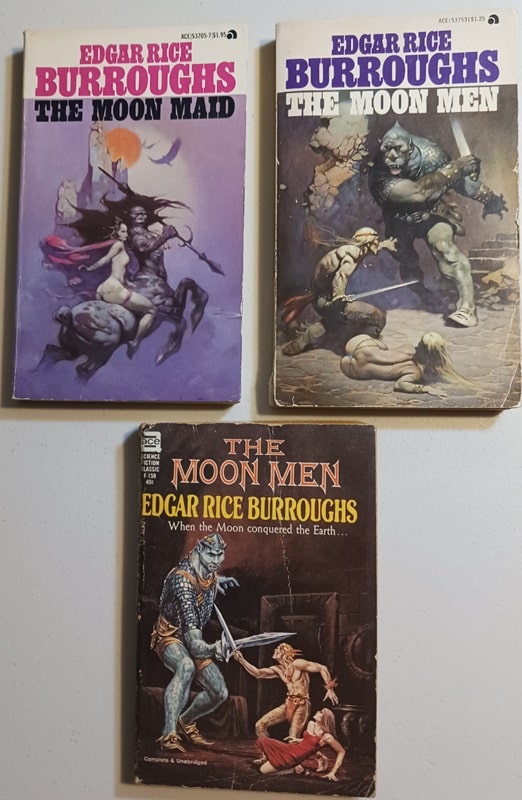 The Moon Maid, The Moon Men, and The Moon Men (Ace Books, January 1974, March 1974, and October 1962). Covers by Frank Frazetta, Frazetta, and Ed Emshwiller
The Moon Maid, The Moon Men, and The Moon Men (Ace Books, January 1974, March 1974, and October 1962). Covers by Frank Frazetta, Frazetta, and Ed Emshwiller
I enjoyed ERB’s Venus books a lot but they were not the equal of his Mars books — in my opinion. A lot of this has to do with Carson Napier. He’s no John Carter. He is a hero, and brave, but he makes plenty of mistakes and often needs to be rescued himself. He also uses more advanced weapons — essentially ray-guns — on many occasions. That means less “swashbuckling,” a minus for me. Certainly, though, if you’re interested in S&P fiction, the Venus books are a must.
The Venus books have been released in various editions. The pictures I have above mix older and newer editions. The older ERB books have covers and illustrations by Roy G. Krenkel, Jr, one of my favorite artists. Some of the newer ones have Frazetta images, and Frazetta was influenced by Krenkel.
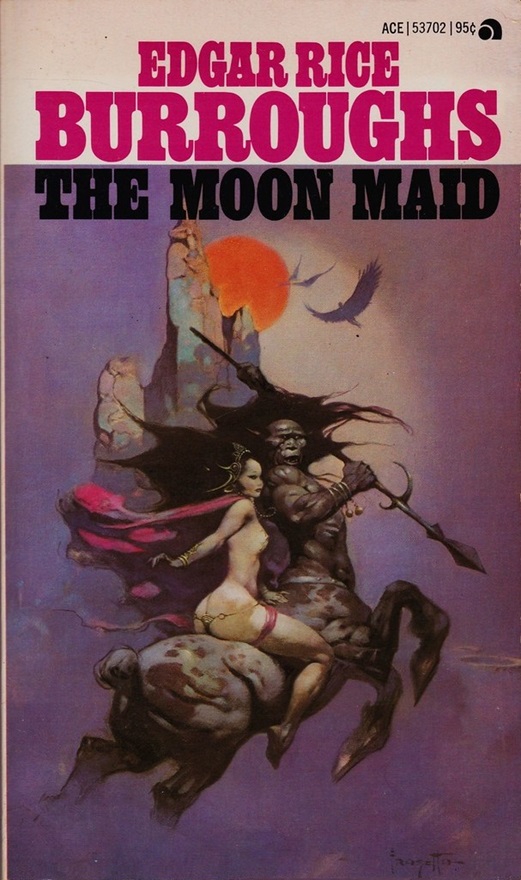 The Moon Maid (Ace Books, January 1974). Cover by Frank Frazetta
The Moon Maid (Ace Books, January 1974). Cover by Frank Frazetta
A series that I would have liked to see more of from ERB was his Moon Maid series. It’s sometimes described as a trilogy, but only the first book is full length. That’s The Moon Maid (copyright 1923). The sequels are novellas called The Moon Men and The Red Hawk (copyright 1925), which I first read combined in a later Ace book called The Moon Men. The novellas are reprinted from the pages of Argosy All-Story Weekly, where the tales were first serialized in 1925.
The Moon Maid has an awesome Frank Frazetta cover that is one of my favorites among his works. I have two copies of The Moon Men, one with a Frazetta cover and the other with a cover by Ed Emsh.
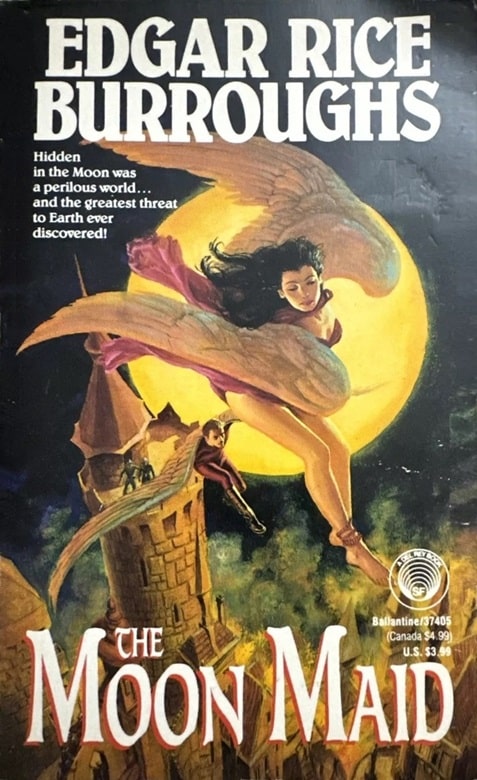
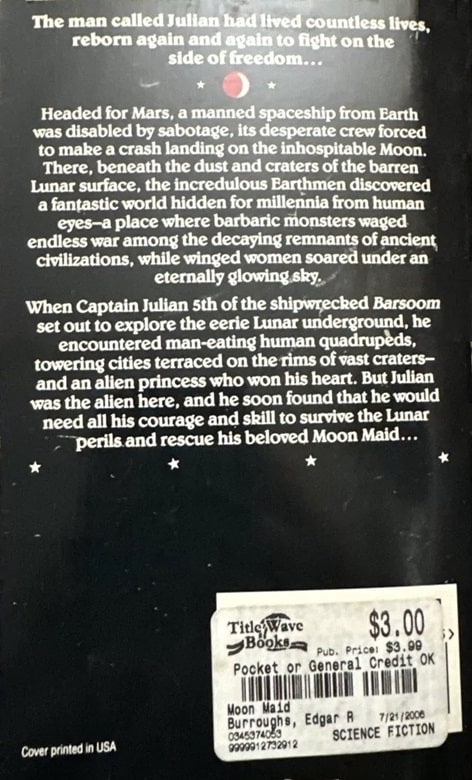
The Moon Maid (Del Rey Books, May 1992). Cover by Laurence Schwinger
The hero in The Moon Maid is Julian the 5th, an Earthman who has lived through many previous incarnations and remembers them. He is leading a rocket ship journey to Mars when the ship has to make a forced landing on the Moon.
They find an oxygen atmosphere inside the moon, and a wild land of strange creatures, including human-type and centaur-type intelligent races. Julian meets a princess of the human-type, Nah-ee-lah, and must rescue her. There’s lots of action and hand to hand combat, although not a lot of sword fighting. I would classify it as S&P.
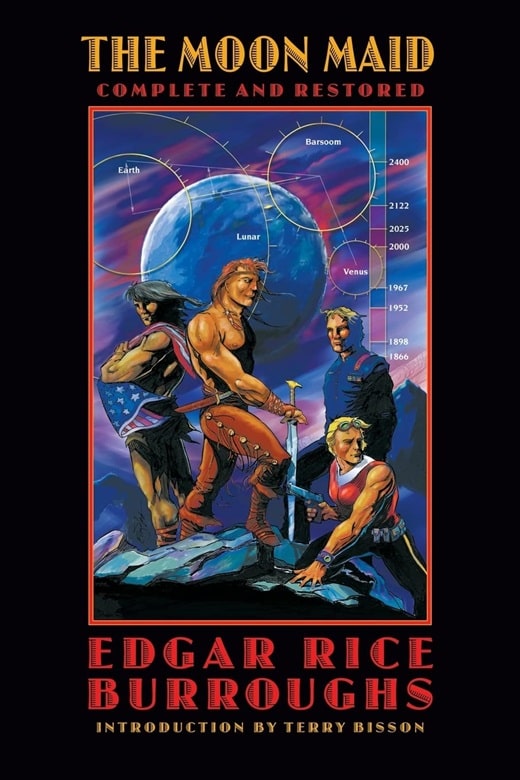
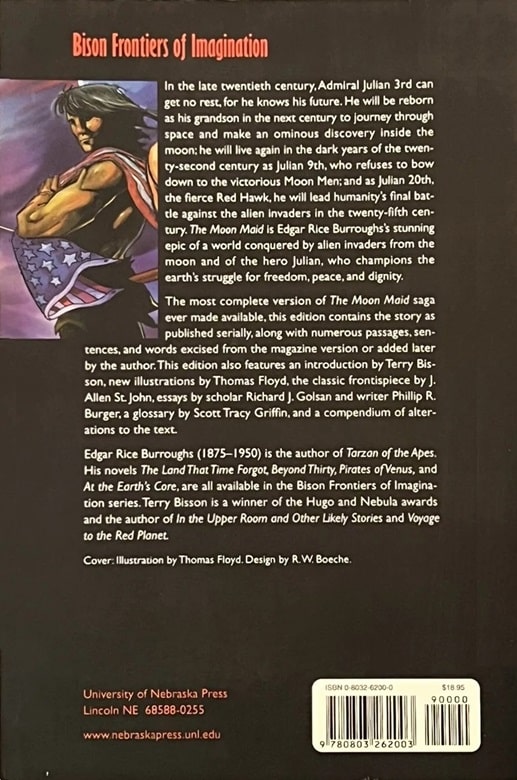
The Moon Maid: Complete and Restored (Bison Books, April 2002). Cover art by Thomas Floyd
The Moon Men and The Red Hawk are not — properly speaking — S&P fiction, because they take place on Earth. In The Moon Men, the Kalkar inhabitants of the Moon have conquered Earth. Julian the 9th, another reincarnation, leads a revolt, but it remains to “Red Hawk,” a descendent of Julian to finally free Earth from the Lunarians’ rule.
The three parts of the Moon trilogy have been published together by Bison books along with all kinds of extras (see above). I don’t have that copy yet but will get it for my collection. The series is one of ERB’s best.
More on Burroughs, including Tarzan and The Land that Time Forgot, in my next post.
Charles Gramlich administers The Swords & Planet League group on Facebook, where this post first appeared. His last article for Black Gate was The Masters of Narrative Drive.
Spotlight on “Victorian Psycho” by Virginia Feito
Victorian Psycho is soon to be a feature film from A24 starring Margaret Qualley and…
The post Spotlight on “Victorian Psycho” by Virginia Feito appeared first on LitStack.
On McPig's Radar - Never the Roses
Did I already read this? Yes!
Am I still totally looking forward to getting this beauty in my eager trotters? YES!
Believe me: you want this book! It's utterly amazing and beautiful in and out!
Go preorder: I totally did.
 Never the Rosesby Jennifer K. Lambert
Never the Rosesby Jennifer K. LambertUNSTOPPABLE WAR. UNSPEAKABLE SINS. IMPOSSIBLE LOVE.
Genevieve Gornichec’s The Witch’s Heart meets Madeline Miller’s Circe in this epic and deeply emotional romantic fantasy debut by Jennifer K. Lambert. The hardcover edition features beautiful stenciled edges.
The Dread Sorceress Oneira has retired. She’s exhausted from fighting the endless wars of kings and queens, and has long accepted that her death is near. Alone at last but for a few uninvited companions―a near-mythical wolf, a goddess’s avatar, and a feline that embodies magic itself―Oneira realizes that she’s bored. On a whim, or perhaps at the behest of fate, she makes an unlikely trip to the most extensive library in existence: the home of her most powerful rival, the sorcerer Stearanos.
By recklessly stealing a book from him, Oneira inadvertently initiates a forbidden correspondence. Taunting notes and clever retorts reveal a connection neither has found―nor could ever find―in any other.
But Oneira soon learns that Stearanos, bound to a vile king, is tasked with waging war on the queen she once served. A relationship with him is far too dangerous to pursue despite their mutual desire―and yet, Oneira can’t seem to stay away.
A bond with Stearanos could alight the long-extinct flame of life within her… or it could destroy her entirely.
Expected publication July 8, 2025
Review: Grave Empire by Richard Swan

Buy Grave Empire OFFICIAL AUTHOR BIO: Richard Swan is a critically acclaimed British genre writer. His debut fantasy novel, The Justice of Kings, was an instant Sunday Times bestseller and has been translated into seven languages. His other work includes the Art of War and Great Silence trilogies, as well as short fiction for Black Library and Grimdark Magazine.
Richard is a qualified lawyer, and before writing full time spent ten years litigating multimillion pound commercial disputes in London. He currently lives in Sydney with his wife and three young sons.
FORMAT/INFO: Grave Empire will release on February 4th, 2025. It will be available in paperback, ebook, and audiobook formats.
OVERVIEW/ANALYSIS: Renata Rainer's job is a joke. As ambassador to the Stygion mermen, she largely has given up hope of ever being useful, given that the mermen want nothing to do with humans. But when two monks arrive claiming to have lost contact with the afterlife, suddenly Renata finds herself in the midst of a critical mission. The Stygion are some of the world's foremost arcana practitioners, and it's up to Renata to verify if recent portents do indeed herald an apocalyptic event known as the Great Silence. But Renata's not the only one interested in the Great Silence - and there are those who want help along the end of the world instead of stopping it.
Grave Empire is a haunting, harrowing journey that envelopes you in its atmosphere, while asking readers for patience in experiencing the actual payoff. This is a story of three individuals scattered across an empire who are realizing that a Very Bad Thing is coming. One is unraveling the secrets of a mysterious plague, another must travel through a warzone to consult with magic practitioners who can shed light on an ancient prophecy, and another is investigating strange reports on the frontier of the empire. Each story is compelling and unsettling, as our characters come to understand just how very wrong things are.
And yet when the dust settled, it felt like all that had been accomplished was learning that yes, a Bad Thing is coming and it is a VERY Bad Thing. The nature of the Great Silence is absolutely a satisfactory threat, and I look forward to seeing how our characters try to handle it, especially as some dominoes began tipping at the end of our story. But this first book is essentially all table setting. Here is the empire, here are the characters, here is the state of the mortal plane, here are some of the weird things that are happening. Will we explain how these weird things are tied together? Not really.
I do want to touch on the relationship between the Empire of the Wolf trilogy and this new The Great Silence trilogy. You do not need to have read the first trilogy to enjoy this new series; the events of Empire of the Wolf are as removed from the characters as the Napoleonic Wars are for us. Those events were definitely a big thing that happened, but they don't inform the characters' day to day lives.
The writing here is also more accessible than the previous trilogy. The first series was told first-person memoir style, while this new one is told across three third-person POVs. I think it also reflects the difference in tone between the two stories. Whereas Empire of the Wolf was a more personal journey of an individual caught up in world-shaking events, Grave Empire feels a little more big picture, a view of how several nations will grapple with a new threat.
CONCLUSION: I want to be clear, overall I really enjoyed Grave Empire, even if the ending left me a bit underwhelmed. I remain hopeful that the second book in this trilogy is going to take everything in the first book and use it for a fantastic sequel. In reading the first trilogy set in this world, I was lukewarm on book one, and then the sequel was one of my top reads the following year. Given how monumentally unsettling the nature of the Great Silence is, I think there's every chance this series will follow in its predecessor's footsteps.
Howard Andrew Jones, a Mentee’s Perspective
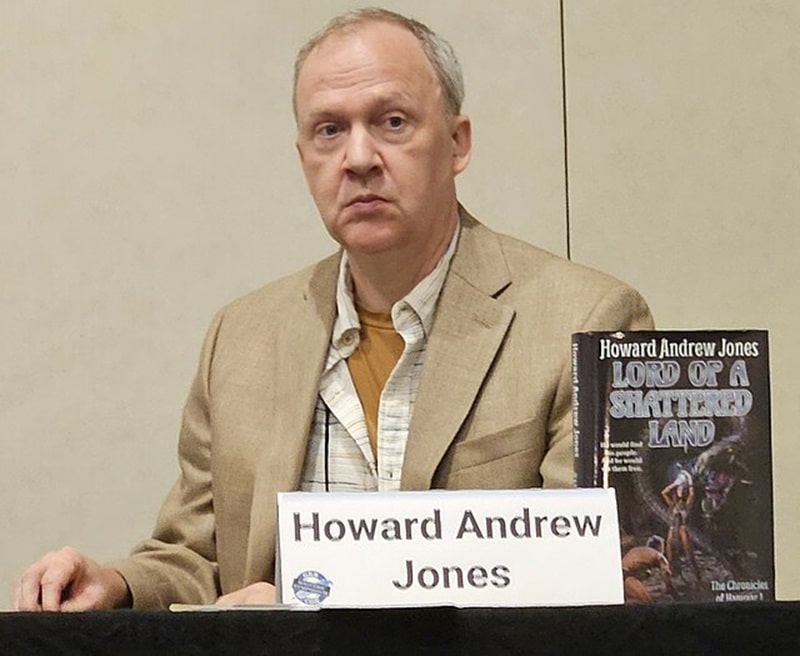 Howard Andrew Jones at GenCon, 2023
Howard Andrew Jones at GenCon, 2023
In 2019, I had an idea: a lot of my friends loved reading sword and sorcery fiction, but they didn’t write it. They would say, “One day.” Many of my undergraduates also expressed interest in writing fantasy, but they often felt discouraged by form rejection letters (genre magazine slush piles are epic). Having studied the history of genre fiction, I knew about the old tradition of “fanzines”— not-for-profit amateur publications that provided a low-stakes outlet for new writers. Just submitting work, collaborating with an editor, and seeing it in print can transform someone’s self-image from being just a reader to being a writer.
So, after some conversations with friends and a bit of encouragement, I started thinking seriously about launching my own zine.
As an academic, I’m deliberate by nature. I like to consult and take my time. Honestly, if I could have formed a committee for this, I probably would have. Instead, I decided to email someone: Howard Andrew Jones.
[Click the images for larger versions.]
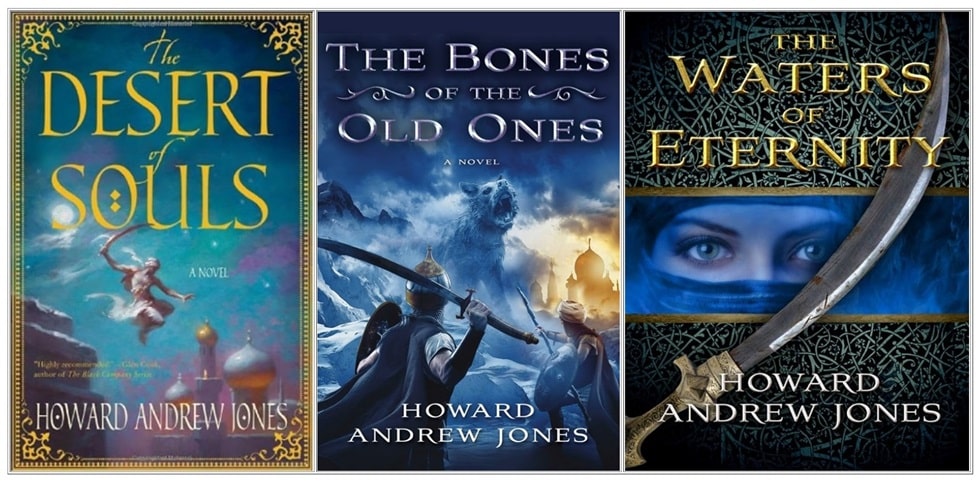 The three Dabir and Asim volumes: The Desert of Souls, The Bones of the Old Ones, and the collection The Waters of Eternity (Thomas Dunne Books, February 2011, December 2012, and November 2011). Covers by Charles Keegan, Steve Stone, uncredited
The three Dabir and Asim volumes: The Desert of Souls, The Bones of the Old Ones, and the collection The Waters of Eternity (Thomas Dunne Books, February 2011, December 2012, and November 2011). Covers by Charles Keegan, Steve Stone, uncredited
At the time, I didn’t know Howard personally, but I knew of him. He was a celebrated name in sword and sorcery. Howard had published an e-zine (Flashing Swords) in the genre, written essays and edited for Black Gate, and authored an incredible series of novels set in a sword-and-sorcery-inspired Arabia featuring Dabir and Asim (The Desert of Souls and The Bones of the Old Ones). He was also working on a new trilogy, The Ring-Sworn Trilogy, and I had already read the first book.
On top of all that, Howard had written several fun Pathfinder RPG novels, and he was editing Tales from the Magician’s Skull, the magazine for contemporary sword and sorcery fiction, published by Goodman Games. I loved that magazine. If anyone could give me advice on starting a zine, it was Howard.
I didn’t expect much when I emailed him. I wrote a long message, gushed a bit as a fanboy, and sent it off. Honestly, I wasn’t really expecting a response.
The next day, I was in my campus office grading papers when my office phone rang. My office phone never rings. In my ten years at CNU, maybe one student has ever called me. It’s practically an artifact – a dusty relic of a bygone era. My first instinct, as a millennial, was to let it go to voicemail. That’s what you do: let them leave a message and call back after some breathing exercises.
But for some reason, I picked it up.
“Hello?”
“Jason?”
“Yeah, this is Jason.”
The voice on the other end was calm, relaxed, with a kind of deliberate enunciation.
“Heeey, Jason! This is Howard.”
“Howard?” I said, not quite connecting the dots.
“Howard Andrew Jones. You emailed me about a magazine idea.”
I still get a little emotional thinking about that first call. Maybe I’m projecting, but I was immediately surprised, disarmed, and touched. Howard had gone out of his way to call me – call me! My office number isn’t even in my email signature, so he must have looked me up online to find my CNU contact info. I hadn’t even expected a reply, and here was this great author, taking the time to phone me.
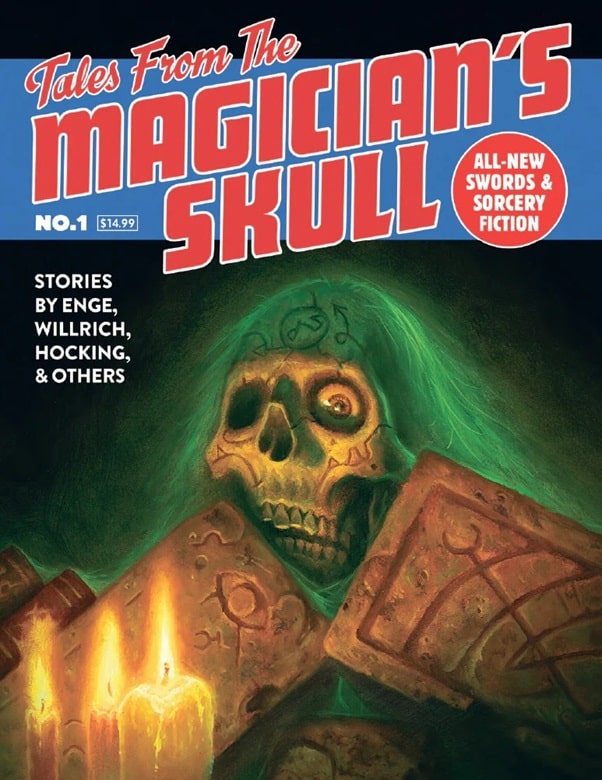
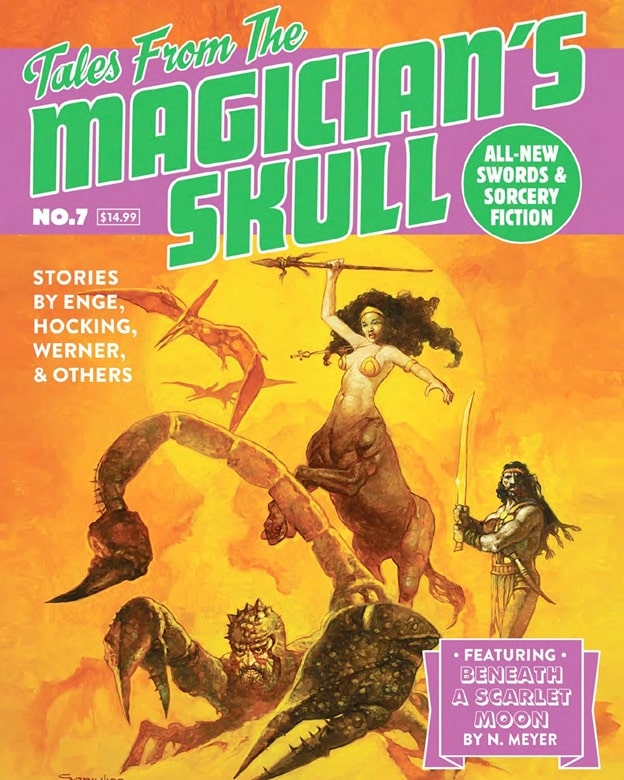
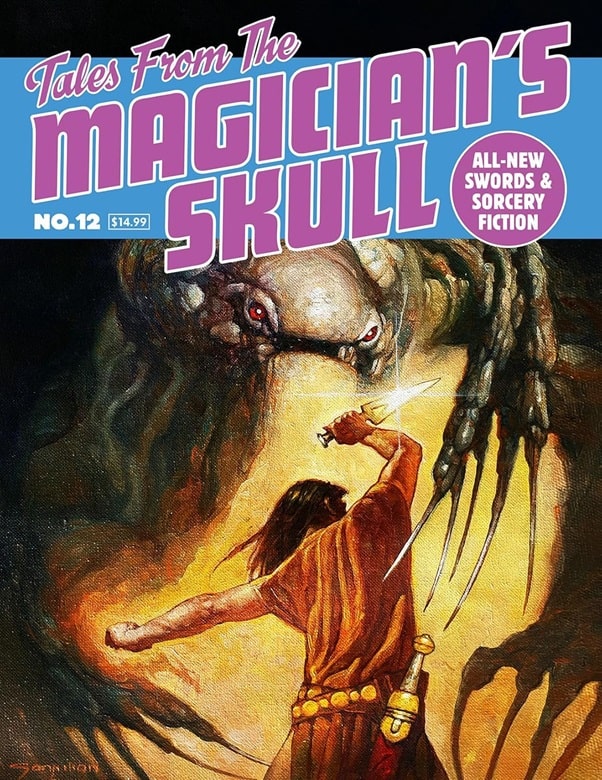
Tales of the Magician’s Skull, edited by Howard Andrew Jones. Issues 1, 7, and 12
(Goodman Games, 2017, 2022, and 2024). Cover art by Jim Pavelec and Sanjulian
I was a bit starstruck when we first talked. I’m already an awkward person, but the awkwardness was dialed up as I tried to gather my bearings. Howard, however, was so kind, calm, and genuinely enthusiastic about fiction, writing, and fantasy literature that I found myself speaking to him like an old friend. I’m pretty sure we talked for over an hour during that first conversation. I remember he was multitasking while on the phone – taking out the trash or doing yard work.
In the years that followed, whenever I spoke to Howard, he always seemed to be en route somewhere – driving to town, running errands, sometimes saying, “Hold on, I’ve got to grab this thing.” He felt real and grounded in a way that made people feel at ease. He gave off this sense of being completely unaware of how cool he was or how others saw him – or, if he did know, he just didn’t put much stock in it.
Over the next five years, Howard and I stayed in almost constant contact. We texted regularly. Often, he’d reply to a message with something like, “You free? Driving to town.” When I started my magazine and created an associated Discord server, he joined and became as active there as anyone, if not more so.
His comments were always supportive, kind, and encouraging. He shared favorite authors, thoughts on prose style, and a steady drip of wisdom for aspiring writers. Whenever anyone mentioned his work, he would chime in, “Thanks for reading it,” “Glad it worked for you,” “Really appreciate the kind words.”
Outside of Discord, we talked on the phone often. One thing I noticed was that Howard frequently mentioned his friends – not in a name-dropping way, like he wanted you to know he knew big authors, but in a way that made you feel like you were part of this collaborative effort, this network of fellow creatives. To him, it seemed, writing wasn’t a solitary pursuit but a shared craft. It was like Howard was always attending a seminar on fiction, and his calls were a way of touching base to see how your progress was going.
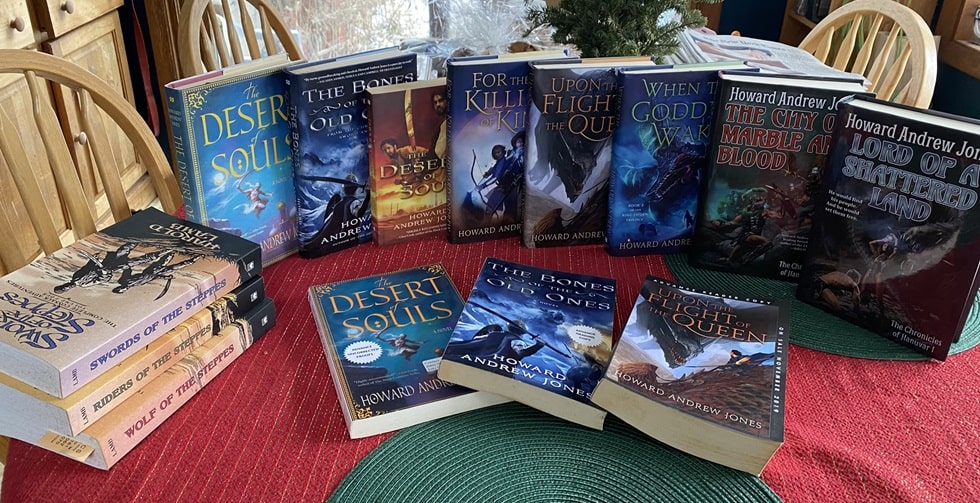 The books of Howard Andrew Jones
The books of Howard Andrew Jones
For instance, he’d say something like, “Hocking and I were talking about dialogue – how it needs to reveal character but economically, like in hardboiled detective fiction” (I’m paraphrasing). From the way he spoke, I got the sense that Howard had a lot of writer friends, and they talked about the craft of writing the way master carpenters might talk about solving technical problems with wood.
Fandom can get a little gossipy, but Howard never said a negative thing about anyone. He was almost stubbornly kind and assumed the best intentions from people. Being in touch with him felt like being welcomed into a very supportive club. Over time – without me even realizing it – Howard became something of a mentor or even a sensei in sword and sorcery writing.
At first, we just talked about sword and sorcery (a genre he was deeply opinionated about – he really didn’t like Tros of Samothrace (“Bounced right off it)), but our discussions evolved into broader topics: writing, work, heroism, and how storytelling affects people’s lives. I can honestly say I learned a lot about writing from him, at least an MFA’s worth, or more.
I met Howard in person three times over the six years I knew him. I saw him at GenCon, the big gaming convention that also includes a section for genre writers. We sat on several panels together discussing sword and sorcery fiction. He attended Howard Days, a celebration of Robert E. Howard, the pulp author who created sword and sorcery (yes, it gets confusing). And then I saw him again at GenCon this past August of 2024.
In August, aside from a persistent leg injury, Howard seemed… OK. I need to be honest and say he struck me as a little blue at GenCon, and he suspected it was due to the injury or the associated medication treating it. He had every reason to be happy. He had just published the first two books of his Hanuvar series. If I remember correctly, book three, Shadow of the Smoking Mountain, had just come out or was coming out. At the convention, he gave me an ARC and signed it with the words, “Find a way or make one.” I took this as a nod to the writer’s life, a reminder to persevere and create despite the challenges.
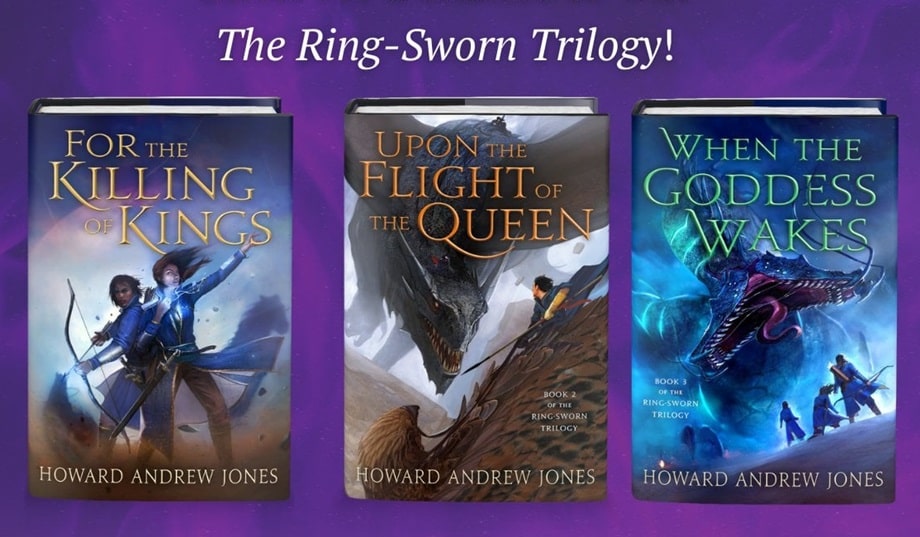 The Ring-Sworn Trilogy by Howard Andrew Jones (St. Martin’s Press, 2018-2021). Covers by Lauren Saint-Onge
The Ring-Sworn Trilogy by Howard Andrew Jones (St. Martin’s Press, 2018-2021). Covers by Lauren Saint-Onge
On the last day of GenCon, literally just before leaving, Howard, my wife Nicole, and I had lunch together. It was the first time Howard had met Nicole. She joked and referred to Howard as “my friend in my pocket” because I was always texting with him. I laughed and told her, “You don’t understand – this guy is so cool. He’s the nicest guy you’ll ever meet.”
That might sound like grief-motivated hyperbole now, but, in hindsight, it wasn’t. That’s exactly how I spoke about Howard before I knew anything was wrong.
Nicole and I had lunch with him, and of course, they hit it off. I can’t recall the details but Howard was fascinated with Nicole’s life growing up on a farm (did Howard come from a rural background?). After the meal, Howard said he was glad to have met her.
We left the restaurant. There were hundreds of people in the corridors at GenCon, a veritable sea of humanity, and Nicole and I were ready to leave, luggage in hand. So, we said our goodbyes. I had no idea it was the final goodbye. Howard gave me a hug and said, “Well, safe travels to you and your beautiful wife. And, keep writing.” Then he disappeared into the crowd.
A few weeks later, I learned he had gone to the hospital with acute symptoms.
I’m still in the anger phase of all this. Howard was such a good guy. It felt like, as a writer, he was hitting his peak. In my view, he had so much more to give the world – not just through his novels but through who he was as a person. I know my story is just one of many similar ones. That’s the kind of person Howard was: everyone who met him seemed to come away with a story about his kindness. This tragedy couldn’t have happened to a more undeserving person.
Howard, you’ll be missed, man. Thanks for being you.
Jason Ray Carney is a Lecturer in Popular Literature at Christopher Newport University. He is the author of the academic book, Weird Tales of Modernity (McFarland), and the fantasy anthology, Rakefire and Other Stories (Pulp Hero Press). He edited Savage Scrolls: Thrilling Tales of Sword and Sorcery for Pulp Hero Press and is an editor at The Dark Man: Journal of Robert E. Howard and Pulp Studies and Whetstone: Amateur Magazine of Sword and Sorcery. His last article for Black Gate was a review of Lord of a Shattered Land.

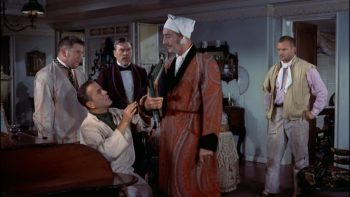
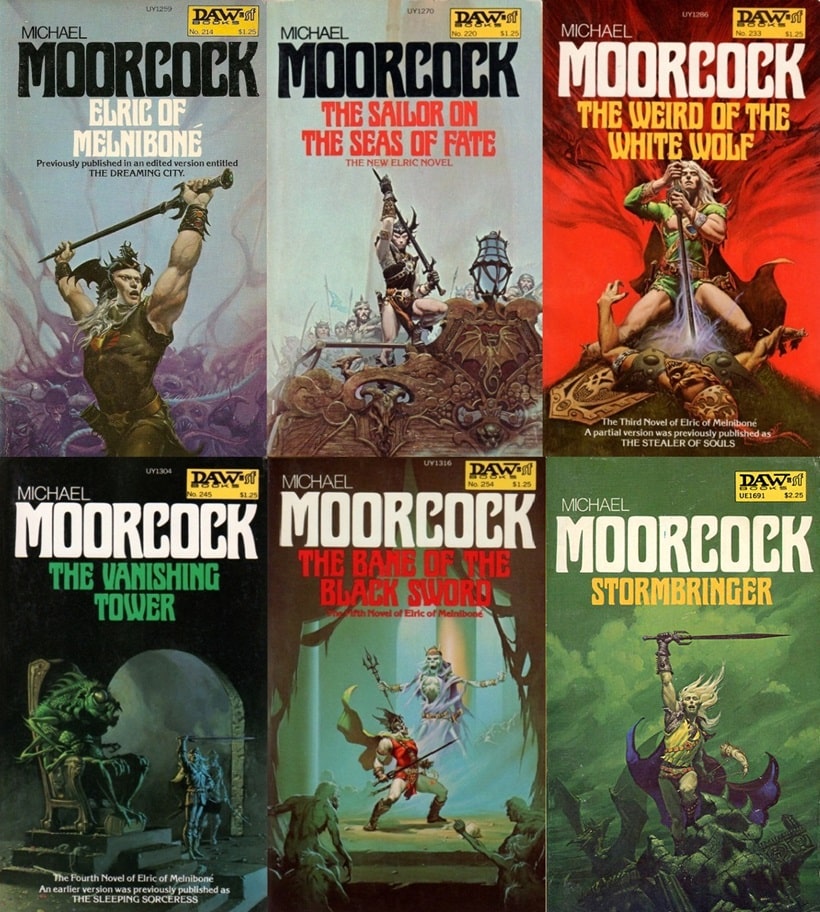
Recent comments